
The future of PFI — trusts told to act now before it’s too late NHS capital budgets must double to protect the estate
Decommissioning medical gases helps to drive carbon efficiencies
The evolution of healthcare fencing design





The future of PFI — trusts told to act now before it’s too late NHS capital budgets must double to protect the estate
Decommissioning medical gases helps to drive carbon efficiencies
The evolution of healthcare fencing design



Welcome to the second edition of Healthcare Property magazine, which comes at a time when the spotlight is very much on NHS budgets, particularly the lack of capital in the system.
With a General Election expected later this year, public spending will be a key focus, and it couldn’t come at a better time, with recent ERIC data revealing the cost to eradicate the current NHS estates maintenance backlog is a staggering £11.6bn — an increase of 13.6% since 2021/22.
In contrast, the private healthcare market has seen a growth in admissions across all UK nations, leading to increased investment in real estate.

In this edition of Healthcare Property, we look at some of the current trends, including coverage of Christie & Co’s new Business Outlook 2024 report, which reveals that rising operator optimism and increased activity are fuelling interest in the sector.
And a new report from Knight Frank shows the health and care property market is one of the fastestgrowing across the globe, with private equity, REITS, and institutional investors chasing the ‘strong, long income’ generated.
You can also read about the Government’s pledge to deliver more than 160 community diagnostic centres (CDCs) as we ask whether these much-needed facilities are having the desired impact on improving access to healthcare services for patients.
According to the findings of the All-Party
Parliamentary Group (APPG) for Diagnostics, there remain key questions over their efficacy, including concerns over location, staffing, and data sharing.
Elsewhere, there is news of the latest projects and information on construction trends, including digital adoption.
And features include work being carried out to eradicate nitrous oxide from hospitals, the evolution of fencing design for healthcare facilities, and the latest carbon reduction efforts in the public and private sectors.
The NHS is currently responsible for 5.4% of total UK carbon emissions, and with a net zero target of 2040, work is underway to improve energy efficiency and climate resilience.
This is driving a fresh approach to property investment and development, as we head towards a more-sustainable model.
With so many issues facing the sector, it is expected that capital spending and real estate investment will continue to dominate headlines, and this brings both opportunities and challenges.
Throughout 2024 Healthcare Property will be reporting on all of these issues, providing industryleading insight and commentary, as well as showcasing some of the innovations in products and services.
If you have any news or views to share with readers, please contact joanne.makosinski@nexusgroup.co.uk
Jo Makosinski Editor, Healthcare PropertyAbout Jo: Jo is the editor of Healthcare Property, having joined Nexus Media in November. She has been specialising in design and construction best practice within the health and care sector for the past 14 years, working on the Building Better Healthcare
Awards and editing both Building Better Healthcare and Healthcare Design & Management magazines. She has a special interest in the design of mental health and dementia care settings and in modern methods of construction and energy efficiency.



Chief executive officer
Alex Dampier
Chief operating officer
Sarah Hyman
Chief marketing officer
Julia Payne
Editor Joanne Makosinski joanne.makosinski@nexusgroup.co.uk
Reporter and subeditor
Charles Wheeldon
Business development director
Mike Griffin
Advertising & event sales director
Caroline Bowern
Business development executive
Kirsty Parks
Sales manager
Luke Crist
Publisher
Harry Hyman
Investor Publishing Ltd, 5th Floor, Greener House, 66-68 Haymarket, London, SW1Y 4RF
Tel: 020 7104 2000
Website: www.healthcare-property.com
Healthcare Property is published six times a year by Investor Publishing Ltd.
ISSN 3029-0627
© Investor Publishing Limited 2024
The views expressed in Healthcare Property are not necessarily those of the editor or publishers.
@HCprop

linkedin.com/company/healthcare-property/
We round up the latest big stories, including new health and care projects, the decision by the Scottish Government to halt hospital construction projects for at least two years, and calls for an increase in capital funding from the NHS Confederation
Exploring whether NHS England’s investment in 160 community diagnostic centres is delivering on its aims
An overview of the key trends in real estate financing for the health sector, including new reports from Christie & Co and Knight Frank, plus we look at the future of PFI as the health sector prepares for

Special report on how making improvements to medical gas supplies can help hospitals to


Exploring the health sector’s net
Architects and contractors turn to technology to reduce the


Modern methods of construction (MMC) underpin the creation of the next generation of care homes, plus we look at how the concept of a ‘village campus’ is setting a new benchmark for the future design of mental health units
and why fencing design is evolving to support safety and security and enhance the healing environment
Staffing and people news, including the latest appointments
The Scottish Government has ruled out new hospital construction projects until 2026 at the earliest, it has been reported.
NHS Lothian finance director, Craig Marriott, said ministers north of the border had told local health chiefs they would be waiting ‘at least’ two years for any estates improvement works, potentially putting jobs at risk and severely disrupting the supply chain.
Daily Business reports that letters have been sent to project managers, building firms, and architects outlining the clampdown, which will also affect NHS activities and staff.
The decision follows cutbacks announced in December’s Scottish Budget.
Sources say a number of firms and recruitment agencies have been forced to withdraw job offers made to candidates linked to a number of developments which will now not go ahead.
Daily Business contacted one health board, NHS Lothian, whose director of finance, Craig Marriott, issued a statement

saying: “New construction projects are dependent on approval and funding from the Scottish Government.
“Following the Budget announcement in December, the Scottish Government advised NHS boards to immediately stop any project development spend as the
Scottish Government does not anticipate starting construction of any new capital projects over the next two years at least.
“Staff and partners are being made aware of the current picture and will be kept updated.”
But sources say that some big developments, including
some that are well advanced, will go ahead, such as the new Monklands Hospital in Lanarkshire.
A Scottish Government spokeswoman issued a brief statement on the health board letters, saying: “This is not for the Scottish Government to comment.”

Kier has been appointed by the Sussex Partnership NHS Foundation Trust to deliver a new £60m 54-bed acute inpatient mental health hospital in Bexhill as part of its Re-designing Inpatient Services in East Sussex (RIS:ES) Programme.
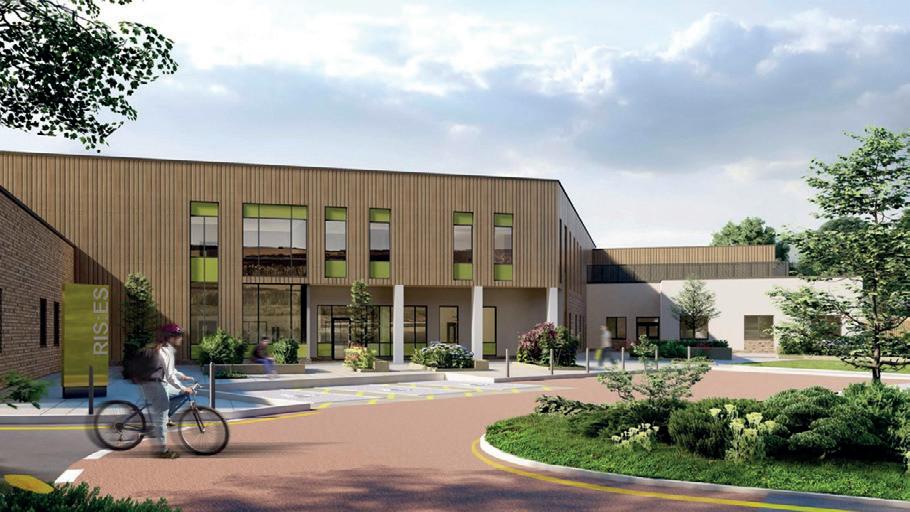
This is the first step in the RIS:ES Programme, which will bring all mental health inpatient services across East Sussex together on a single site.
The new 57,393sq ft facility will replace outdated services currently provided in the Department of Psychiatry at
Eastbourne District General Hospital.
There will be three 18-bed wards, all with individual bedrooms and ensuite bathrooms, surrounded by attractive and therapeutic landscaped green space.
The new building will also
provide outpatient services as well as training facilities for medical and other related professions.
And it will be fully electric and highly insulated, with energyefficient systems implemented to reduce energy usage and optimise environmental performance, including solar panels and a range of electric vehicle charging pointspoints.
In addition, the car park has ‘rain gardens’ that collect the surface water run-off, filtering it into a storm water attenuation tank before it is discharged directly into the ordinary watercourse.
Morgan Sindall Construction has been appointed to create a new Community Diagnostic Centre (CDC) at St Margaret’s Hospital in Epping.
Commissioned under the ProCure23 (P23) framework for the design and construction of NHS capital projects, the CDC is the main aspect of three streams of work the tier one contractor is delivering for The Princess Alexandra Hospital NHS Trust (PAHT).
This phase of the project is to be completed in 2025, with plans for further services on the site to be confirmed.
The work will significantly improve access to important healthcare equipment and skills, shortening the amount of travel time for NHS patients in the area.
In phase one, Morgan Sindall will refurbish and add an extension to a bungalow on the St Margaret’s Hospital site.
PAHT has been allocated over £14m for this project, which will enable the buildings to house MRI scanning facilities as well as outpatient services.
This will be one of approximately 30 new centres in the UK, which are part of a government initiative following the COVID-19 pandemic to move diagnostics out of acute hospitals and into community sites to provide easier public access and earlier diagnosis.
As part of its Intelligent Solutions approach to construction, Morgan Sindall will utilise its digital carbon analysis tool, CarboniCa, during the project. This will inform carbonrelated decisions throughout the design and construction phases to minimise emissions and ensure the building is as sustainable as possible.
By retrofitting existing buildings, rather than creating new ones, PAHT is significantly reducing its carbon footprint by avoiding the materials, waste, and resources that a newbuild development would incur.
Morgan Sindall will also be working with the trust to deliver important refurbishment work at The Princess Alexandra Hospital in Harlow.
This will include ward refurbishments and upgrades to key areas, which will ensure that the site continues to operate at a high standard until it is replaced by the new hospital.

Peter Whitmore, managing director for Morgan Sindall Construction’s East region, said: “The new West Essex Community Diagnostic Centre will bring a wide range of crucial healthcare benefits right to the doorstep of the community.
“To ensure that this project provides as much value as possible for the local area, we have been collaborating closely with The Princess Alexandra Hospital NHS Trust to create a new facility that will meet the multifaceted needs of the trust and its patients.
“Bringing our expertise in constructing medical environments, as well as in creating sustainable spaces and generating social value, means that this new site will be helping to support future generations in a wide variety of ways.”
Michael Meredith, director of strategy and estates at the trust, added: “The Community Diagnostic Centre at St Margaret’s Hospital will support us to provide modern, integrated, and outstanding care to our local community.
“We will be able to provide quicker access to diagnostic tests, closer to our patients’ homes and are focused on having our patients at the heart of our services, with new and enhanced ways of working and providing care.”
Now in its fourth generation of NHS England’s route to market for the provision of design and construction services to NHS capital projects, the P23 framework is part of the CCS CWAS2 procurement framework.
This ensures that NHS capital works adopt the principles of the Government’s Construction Playbook, modern construction on delivery, and a focus on sustainability and social value.


at Highbury Hospital for Nottinghamshire Healthcare NHS Foundation Trust.
This includes a refurbishment and reconfiguration of Tall Trees, an existing two-storey building, providing office accommodation with meeting rooms, breakout areas, meeting spaces, and staff amenity/rest facilities for the trust’s mental health crisis teams.
The second project, The Glade, is a refurbishment and new-build extension to

provide a new mental healthcare outpatient facility comprising consultation rooms, group activity rooms, reception, a waiting area, and staff facilities.
Works also include a new fenced garden for service users.
And the handover also marks the first anniversary of Sherwood Oaks Hospital, a 5,000sq m complex refurbishment project with new-build extensions.
Spread across three blocks, two of which house four wards and one comprising an administration area, the new site provides
A £29.3m mental health hospital for older adults in Walsall has reached a significant milestone in its build.
A water-tight ceremony has taken place at the site of the new and improved hospital, which is a tradition in the construction industry to mark the point when the building’s exterior has been completed and is protected against the elements.
Staff from Black Country Healthcare NHS Foundation Trust were joined by colleagues from the project team, including Kier Construction, Archus, and Gilling Dod, who gathered to celebrate the important milestone.
The project includes the construction of two ground-floor wards with ensuite accommodation, flexible therapy space, and an outdoor garden area.
As well as providing a modern, safe environment, the build also has a focus on energy-efficient design and will have a small number of electric car charge points, a first for the trust.
Jeremy Vanes, chair of Black Country Healthcare NHS Foundation Trust, said: “We


are delighted to have reached this important milestone in the journey to move patients and services to the new and improved hospital.
“It is great to see our plans beginning to take shape and see the progress that has been made.
“This build is a significant investment in
The Sherwood Oaks project generated £6.5m of social value investment back into the community, with particular emphasis on skills and opportunities.
Alongside work placements and employment for local people, the project team engaged local businesses, with 64% of the supply chain being sourced locally, upholding Tilbury Douglas’ commitment to enhancing local economy spend across its projects.
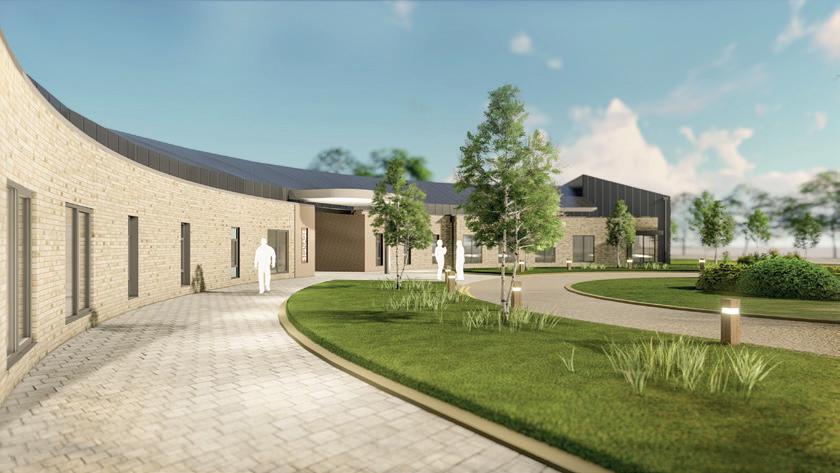
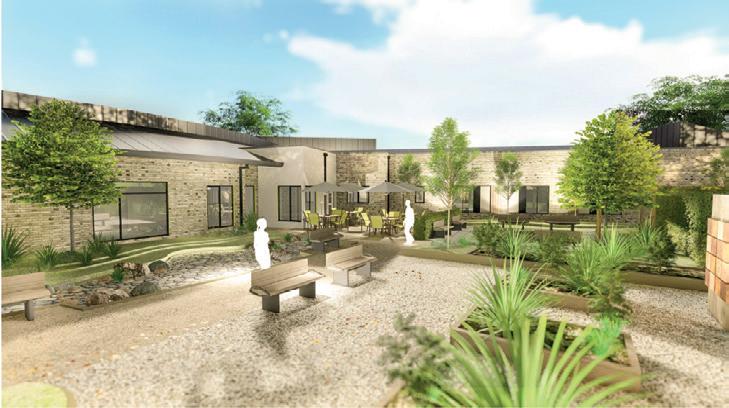
older adult mental health services in Walsall and will improve the care and experience for patients in hospital and we are looking forward to the final phase of the build and developing plans for when we are ready to welcome staff and patients safely on site.”
The hospital is due for completion in summer 2024.
NHS capital budgets must double to ensure the delivery of fast and moreeffective patient care, according to analysis from the NHS Confederation.
The organisation’s Investing to Save: The Capital Requirement for a More Sustainable NHS in England report claims a further £6.4bn of capital funding must be committed through all three years of the next Spending Review — totalling £14.1bn a year — in order to address the mounting backlog maintenance crisis across the NHS estate.
The money will also help with the refurbishment of dilapidated buildings, upgrading of equipment, and an increase in staff productivity, the report states.
Chief executive of the NHS Confederation, Matthew Taylor, said: “Some of our members have parts of their estate that are barely fit for the 19th Century, let alone the 21st, so any future Secretary of State for Health and Social Care must make the physical and digital condition of the NHS a priority if the health service is to reduce backlogs and get productivity levels to where the Government wants them to be.
“Lack of capital across different care

actively undermining it and causing patient safety issues.
“Health leaders across England have endless ideas about how capital funding could drive large productivity increases.”
He added: “Equipping staff with the right
tools, and allowing them to operate in safe, modern, optimised environments will improve efficiency, meaning an increase to the capital budget will help limit the need for growth in revenue spend, relieve pressure on wider NHS finances and services, and put the NHS on the path to longer-term financial sustainability.
“This will require a significant increase to the NHS capital budget to make up for years of underresourcing and repeated raids on capital that has left much of the estate broken.
“Based on the assessment of health leaders, this will need to be an increase of £6.4bn to take the capital budget to £14.1bn for each year of the next spending review in order to fully address the repairs backlog and realise some of the innovative transformation projects which have previously fallen by the wayside.
“The next government must grasp the nettle.”
Also identified in the report is the fact that health leaders across the country have ideas on how care can be improved. However,, these innovative plans are being delayed due to a lack of funding.
Tilbury Douglas has been appointed to lead the construction of the East Midlands Planned Care Centre (EMPCC) on behalf of University Hospitals of Leicester (UHL) NHS Trust.
The centre is one of the most-significant capital developments at UHL in recent years and comprises the total refurbishment of the former Brandon mental health unit, a three-storey building on the Leicester General Hospital site which has stood empty for over 10 years.
Under the scheme the space, dating back to 1977, will be transformed into an exemplar planned care hub to help the trust tackle waiting lists for planned procedures.
The project includes external fabric upgrades, with new wards, theatres, treatment rooms, and support spaces
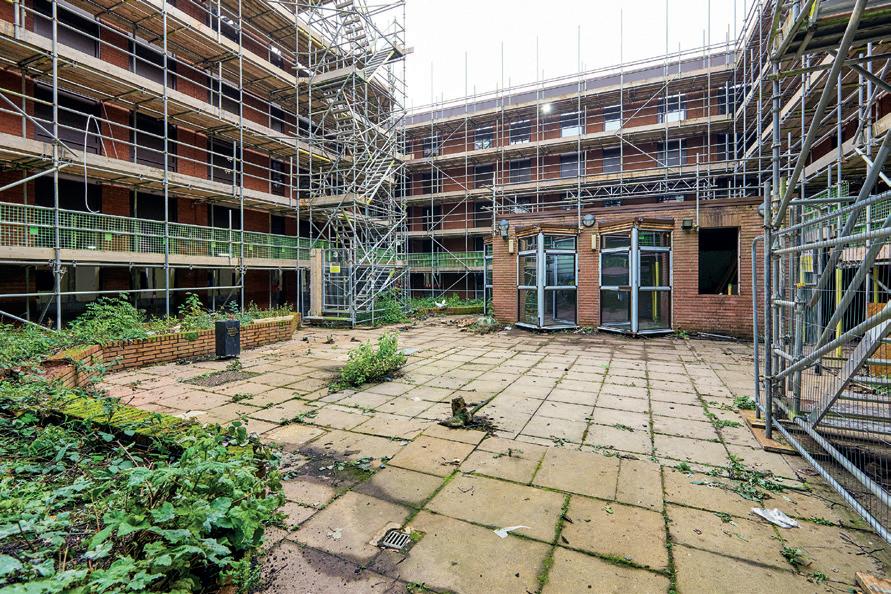
Douglas Engineering, the deliverables will include new plant rooms and boosted water tank installation, which alongside a replacement roof and more than 700 replacement windows and doors, will contribute to the building’s ‘net zero carbon ready’ strategy.
Simon Butler, regional building managing director for the Midlands at Tilbury Douglas, said: “We are proud to be selected to deliver this important scheme, which aims to provide
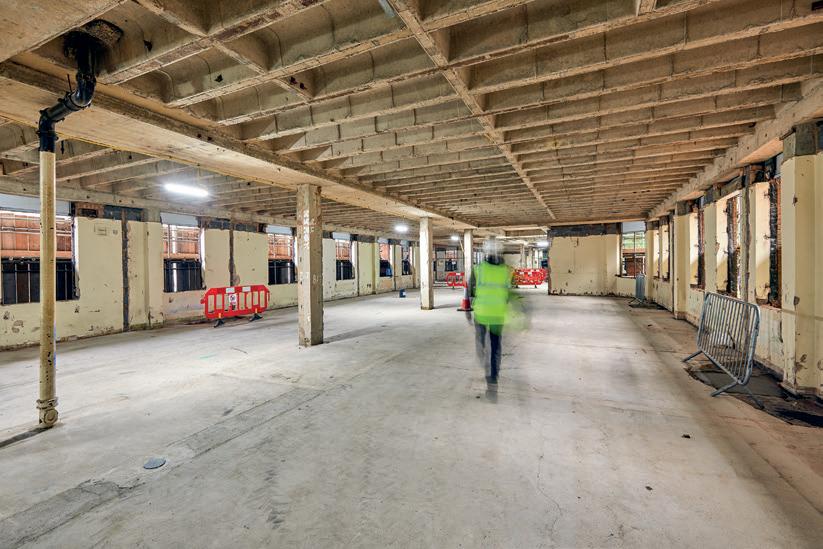

additional capacity for elective procedures for Leicestershire.
“This should enable the
further reduction of waiting lists within the region and allow for improved patient care.”

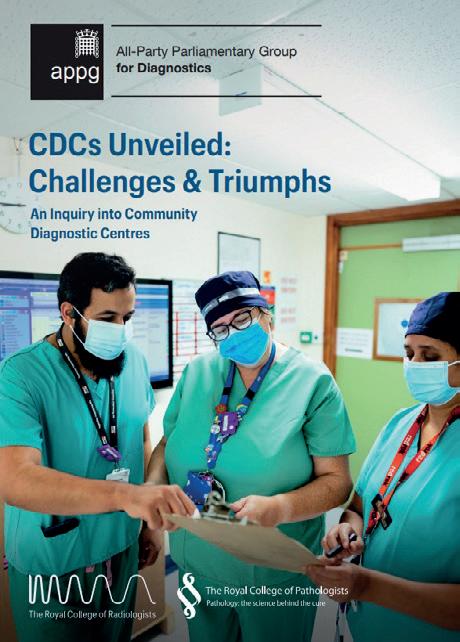
Exploring whether NHS England’s investment in 160 community diagnostic centres is delivering on its aims
In 2021 the Government announced a £350m investment in 40 new community diagnostic centres (CDCs) across England, part of a drive to reduce waiting times, cut down on the number of patients having to visit hospital sites in the aftermath of the COVID-19 pandemic, and achieve earlier diagnoses for major health conditions.
Initially proposed in Professor Sir Mike Richards’ report, Diagnostics: Recovery and Renewal, the one-stop shops for checks, scans, and tests aimed to deliver 2.8 million additional appointments in the first year of operation.
The following year the Government announced plans for an expanded network of 160 centres, supported by the largest central cash investment in MRI and CT scanning capacity in the history of the NHS.
And, in October 2023, the Department
of Health and Social Care revealed it was on track to deliver the facilities a year ahead of the 2025 deadline.
But, has the programme achieved what it set out to do?
In January of this year, the All-Party Parliamentary Group (APPG) for Diagnostics published the findings of an inquiry into CDCs, and it raises key questions about their efficacy, particularly around location, staffing, and shortfalls in technology adoption and data sharing.
The report reveals that NHS England and the Government have made strides in delivering the programme, so far approving 174 CDC sites and opening one in each Integrated Care System (ICS).
However, it reveals concerns over ‘unequal’ geographic distribution and funding constraints for future expansion.
NHS budget deficits, high upfront costs, and risks with privately renting retail spaces limit CDC placement in community hubs and overcoming these obstacles is crucial for ICSs to make the brave choice of placing CDCs where they can significantly impact community healthcare.”
“Analysis of CDC activity reveals a slow pace, with only around five million tests conducted since July 2021 against a target of 17 million by 2025,” it states.
“Collaboration with the private sector has expanded services, but persistent high demand and limited capacity pose ongoing challenges, emphasising the need for continuous scrutiny and transparency from NHS England to assess the impact on patient outcomes.”
A major stumbling block has been the location of the centres.
Initially, the aim of the programme was to enhance diagnostic capacity in underserved communities and enable access to services outside of acute hospital sites.
It was intended that the clinics would be sited in a range of easily-accessible community-based settings such as local shopping centres and football stadiums.
But, in reality, a large number have been co-located on existing hospital sites.
The APPG report states: “Questions remain over how many CDCs are truly community based, with 5.2% and 41% of approved CDC sites located on acute

hospital and community hospital estates respectively.
“NHS budget deficits, high upfront costs, and risks with privately renting retail spaces limit CDC placement in community hubs and overcoming these obstacles is crucial for ICSs to make the brave choice of placing CDCs where they can significantly impact community healthcare.
One of the driving forces behind the decision on location appears to be workforce planning.
The report reveals: “Ongoing staff shortages, demonstrated by shortfall figures and reports of unmanageable workloads, compounded by insufficient workforce planning and funding, limit CDC effectiveness.
“Proposed workforce solutions include acute/CDC rotation models, international recruitment, ‘grow your own’ initiatives, and private sector collaboration, each with its own advantages and drawbacks.
“Ultimately, there is an urgent need to expand the diagnostic workforce in line with growing patient demand.”
The Royal College of Radiologists found that 89% of CDCs are staffed by existing trust employees and warned that rotating staff between the CDC and acute hospital sites may be diluting capacity in both settings.
However, the study also found that, positively, CDCs may also be contributing to the retention of existing staff, with feedback revealing CDCs provide ‘a positive environment’ with ‘better working hours’.
Responding to APPG report’s findings, Charlotte Wickens, policy adviser at health think tank, The King’s Fund, said: “The programme has a wider ambition to deliver diagnostics differently, in a way that tackles health inequalities and moves access to diagnostics into underserved and deprived communities.
“This means the location of the CDCs is also crucial.
“While it might make sense to co-locate CDCs with existing NHS facilities, there

are also benefits to having these centres embedded in the community.
“The Government’s announcement that it will speed up opening 160 CDCs by March 2024 is a good thing for capacity in the NHS, but it is important that this increased pace does not eclipse the ambition for the new centres to improve access for underserved communities.”
She added that setting up CDCs outside of the NHS estate is expensive.
“Upfront costs are high and there are risks associated with using space let by private landlords, while there is also the cost of relocating and maintaining equipment,” she told Healthcare Property.
“And, given the finite pot of funding allocated for the rollout of CDCs, and with all integrated care boards reporting deficits, it is hard to see that the risk and long-term financial commitment associated with locations such as shopping centres could be justified going forward.
“This may result in most CDCs being located on existing NHS estate, potentially preventing them from addressing health inequalities and access issues as originally intended.”
The type of services being delivered within the hubs is also coming under scrutiny.
“CDCs provide essential diagnostic services, encompassing imaging, physiological measurement, and pathology to meet high healthcare demand,” says the APPG report.
“Additional services, tailored to meet local needs, have, and should, be integrated
to establish CDCs as true ‘one-stop shops’ for patients.
“Unfortunately, a lack of data and research limits the assessment of the programme’s effectiveness in achieving this goal.”
Although the CDCs are equipped with up-to-date diagnostic equipment, the report calls for increased adoption of technology to fully realise the ambitions of the programme.
“Digital tools, such as the iRefer tool and NHS App, are vital to streamlining diagnostics, improving efficiency and patient engagement,” it adds.
“Unfortunately, despite pilot projects showing significant benefits, challenges in basic infrastructure, data sharing, and inconsistent digital advancements persist, underscoring the need for additional funding for robust digital infrastructure.”
In response to the criticisms, the Government and NHS England has set out an ambition to increase use of independentsector capacity.
At least eight of the final wave of CDCs, announced last August, will be independently run, functioning like NHS-operated facilities, but staffed by independent-sector employees, with the private provider also owning the building.
Companies signed up to deliver services include InHealth, which is delivering CDCs in a number of locations, including Greater Manchester, Bristol, Ealing, Bicester, Liverpool, Ipswich, and Milton Keynes; and Alliance Medical, which created the country’s first CDC and now operates a network across the country. n

Health trusts operating PFI-funded estates are being urged to act ‘before it is too late’ as the controversial contracts near the end of their lifespan
NHS organisations operating PFIfunded estates are being urged to act ‘before it is too late’ as the controversial contracts near the end of their lifespan.
The Infrastructure and Projects Authority’s (IPA) 2022 report, Preparing for PFI Contract Expiry, recommended that trusts take the next steps at least seven years prior to contract expiry.
That means hundreds of organisations will need to take action now to prepare for handback and decide how they will fund, operate, and maintain their estate moving forward.
And, as many Private Finance Initiative (PFI) contracts also covered the delivery of hard and soft facilities management (FM) services, there will also need to be discussions on how these will be provided in the future.
Government figures from 2018 show the value of the initial investments was £12.8bn, but the Department for Health and Social Care will have spent a total of £80.7bn once they are all paid off.
The long-term contracts — which often spanned a period of up to 30 years — were signed between the NHS and a private
sector consortium, typically a specialpurpose project company, and meant the private sector designed, built, financed, and operated the asset and related services.
Under the contracts, the private party bears the risks associated with construction and maintenance and management responsibility, and remuneration is linked to performance.
There are currently over 120 PFI projects in NHS England, with contracts varying in size, but most including the delivery of hard and soft FM services such as maintenance, portering, cleaning, and catering.
The first deal was signed in July 1997 and successive waves followed until, in October 2018, the Government announced it would no longer support the model.
But now trusts which have operational PFIs need to begin planning for the future, ensuring their estate is handed over in tip-top condition and either finding the inhouse expertise to take over operations, or opting for a new public/private model.
The National Audit Office (NAO) found in its June 2020 report on PFI contract expiry that public sector bodies risk underestimating the time, resources, and complexity involved in managing the end of
Matthew Vickerstaff, deputy chief executive of the IPA, said: “The expiry phase of PFI contracts, including asset handback and the transition to future services provision, presents additional risks, including potential operational disruption, lack of service continuity, financial loss, and reputational damage.
“The effective management of the expiry process is therefore of particular importance.”
The report adds: “The IPA expects that senior leaders will commence planning for PFI expiry at least seven years prior to the contract end.
“Early, but cost-effective steps will need to be taken to increase awareness and active management of the contract in advance of expiry to understand the assets, systems, and people involved in the exit and transition process, build supportive relationships with other parties, and obtain information from the PFI project needed to shape and plan the future provision of services.
“Significant risks will need to be managed, diverse expertise and resources will need to be applied, and additional budgets will likely need to be made available.
“What is certain is that the whole expiry process will require more, and different, senior management support than is currently being provided to the PFI project.”
The IPA guidance is supplemented by an expiry toolkit, which provides additional tools and materials to support authorities in managing expiry.
But what is next for these hospitals?
Speaking to Healthcare Property, Alison Martin, legal director and PFI specialist in international law firm DAC Beachcroft’s infrastructure and projects team, explained: “For the past 30 years a large number of hospitals have been provided via PFI and, from 2030, a lot of those contracts will expire.
“With the IPA guidance recommending planning for expiry seven years out, now is the time for those trusts to start preparing for handback and expiry, and planning what is coming next.
“This will be critical for the NHS in terms of ensuring service continuity and delivery of its healthcare estate.
She added: “It is not yet clear what a successor model for PFI might look like. It could be a centrally-driven standardised approach, or trusts may be allowed more flexibility to design their procurements at


Significant risks will need to be managed, diverse expertise and resources will need to be applied, and additional budgets will likely need to be made available.
a local level. It could also look at bringing it back in-house, but this could present potential resourcing issues in terms of capacity and capability.
“In my view, the private sector will continue to play a part in the NHS estate, particularly in the provision of hard and soft FM services — it’s just what model that will look like.
“Certainly value for money will be key and any replacement will have to be more balanced and focused on value rather than pushing the risk to the private sector.”
Key to the handback will be clarity as to the required condition of the buildings and the respective rights and responsibilities of the parties under the PFI contract.
Martin said: “The NHS can’t make strategic plans for taking these buildings back unless it knows what condition they are in, what condition they are meant to be in, and what is coming next.”
But, threatening to hamper this process, are disagreements as to the condition of the assets and the often-frosty relationships that have grown over time between some NHS organisations and their PFI providers.
Martin explains: “A number of public authorities have been accused by the private sector of taking overly-draconian enforcement measures under the PFI contract — often in an attempt to maximise the level of deductions that can be made for poor performance under the payment mechanism.
“In turn, concerns with the private sector approach have been cited.
“Together, these are said to have driven behaviours, antagonised relationships, and led to a rise in disputes.
“A priority will be to restore those relationships going into the handback process.”
She added: “We have seen a number of NHS PFIs adopt the ‘reset’ approach White Fraiser , with a view to restoring the
“The ‘reset’ approach gives them an opportunity to improve and assure performance of their PFI contract now, rather than waiting until the contract is due
“It provides for the carrying out of an audit of the PFI contract (by way of surveys), and gives the PFI provider a timelimited period within which to rectify any issues identified without threat of being penalised under the contract for non-
“Despite its critics, there are some merits to the PFI model, which have helped transform the healthcare estate over the
“But, ultimately, handback will be used to measure its success and it will take collaboration between the parties to agree on what that ‘success’ looks like.”
Stan Campbell, partner and health property lead at DAC Beachcroft, concludes: “Some of the PFI hospitals are still very cutting edge, but the perception of the associated cost was a problem — stories of companies charging £40 to change a lightbulb eroded public opinion.
“Many also held the view that PFI effectively privatised part of our beloved NHS.
“Within the private sector, there appears to still be an appetite for investing in the NHS estate and a group of investors who want to do well by ‘doing good’.
“We don’t quite know what the future will hold, but to ensure there is sufficient capital investment in NHS infrastructure, the NHS needs to consider what will replace the PFI model.
“It also needs to start conversations with existing providers now to make sure the estate it gets back is the one it paid for.” n
Within the private sector, there appears to still be an appetite for investing in the NHS estate and a group of investors who want to do well by ‘doing good’Stan Campbell


Christie & Co’s new Business Outlook 2024 report reveals the opportunities and challenges within the health and care real estate sector
Rising operator optimism and increased activity are fuelling interest in the healthcare property sector, according to a new report from Christie & Co.
Its Business Outlook 2024 report reflects on the themes, activity, and challenges of 2023 and forecasts what 2024 might bring across key industries, including the health and care sector.
And it reveals that 2023 was a year of consolidation, with the majority of operators reporting that occupancy had returned to pre-pandemic levels.
Staffing issues eased slightly due to the successful recruitment of foreign staff via the sponsorship licence, although this may be impacted by recent immigration policy changes.
But the demand for bed spaces remained high, particularly for dementia care places, and fee increases predominantly kept pace with inflation.
The report also reveals that the transactional market adjusted to an environment of significantly-higher interest rates, placing greater emphasis on debt serviceability, with a 14% rise in completions in 2023 compared with 2022.
However, wider cost pressures had a significant impact on providers of smaller, converted care homes which do not have the economies of scale and are less energy efficient.
This increased the rate of care home closures at a time when demand for bed
spaces should be increasing.
Consequentially, the proportion of closed care homes Christie & Co sold in 2023 increased to represent 19% of its deal volumes, compared with 13% in 2022.
And this trend is interesting as new-build developments are not keeping pace with closure rates.
The number of distressed sales also increased, with Christie & Co noting a 7% rise in 2023.
Positively, though, the company did not see a material deterioration in asset values for going-concern deals — noting a 0.4% decrease in its annual price index, and the performance of the sector fared well compared with other asset classes.
The development market faced stronger headwinds due to construction cost
Good levels of demand and a limited availability of stock enabled pricing to hold up well and, moving into 2024, we are positive about the prospects for the year ahead

inflation and the availability of debt.
However, the need for futureproofed care beds remains undiminished and the underlying ESG credentials, together with future bed demand needs, remain compelling for investors.
As part of its annual sentiment survey, the company surveyed healthcare professionals across the country to gather their views on the year ahead.
And 48% said that they feel positive about the year ahead — a 14% rise on survey figures reported in the previous year
The care sector continues to be well supported by both traditional and alternative funders; with the level of finance Christie Finance generated for its clients having increased by 28% between 2022-2023.
Income potential and cashflows were seen as particularly reliable due to the sector’s needs-driven nature. However, there are now more intense audits, assessments, and monitoring from lenders around how operators will manage the impacts of the rising cost of living and increase in debt costs on their business.

of living mostly now absorbed by operators, should lead to a more fluid finance market.
In 2024, Christie & Co expects:
• Capital values will remain stable with strong occupancy levels and investor demand offsetting higher debt costs
• Capital markets activity will increase with a more-stable interest rate environment
• An increased number of OpCo transactions as operators seek to expand their portfolios without tying up capital in real estate
• Growing distress for smaller assets with rising staffing and capital costs, largely driven by the increasing minimum wage
• New-build development activity will increase across broader geographical regions as operators seek less-competitive operating markets
• Ongoing rationalisation from larger providers and third-sector providers
• Continued protractions and uncertainty in the planning system will constrain the supply of consented care home development sites
Richard Lunn, managing director of care at Christie & Co, said of the findings: “Despite the undoubted economic headwinds, the care sector remained resilient through 2023.
“Good levels of demand and a limited availability of stock enabled pricing to hold up well and, moving into 2024, we are positive about the prospects for the year ahead.” n
An energy broker is offering care home operators the chance to recoup some of their gas and electricity costs as part of an innovative new ‘payback’ scheme. Matt Small, director of T150 Energy,

Small, director of T150 Energy
institutions to hospitality and manufacturing businesses.
Coming from a background in telecoms and a career in the Armed Forces, Matt brokers energy deals between businesses and some of the top energy providers — including British Gas, Opus Energy, YGP,
I am well aware of how woefully underfunded these sectors are and as I work with operators I really wanted to give something back.
engie, Dual Energy, npower, Scottish Gas, SSE, and Gazprom.
And, with energy prices continuing to soar, and the care sector feeling the pinch, he is keen to give something back.
The idea of the payback scheme came when he attended The National Care Awards last November, an event operated by Healthcare Property publisher, Nexus Media Group.
Matt explains: “At the awards I was speaking to operators and care home managers and they were talking about the work they are doing.
“The idea came to me that night and the next day at The Care Managers Show, I was wondering how I could help and what I could do that is different.
“I work with partners who bring me business and I pay them commission for bringing me their clients, so I thought why don’t I do the same for care homes?
“The following day I looked at a few figures and started doing the maths.
“One care home operator I had spoken to had 92 care homes. This would mean a potential payback of £180,000 on electricity alone.”
He added: “My goal for this year is to put
back £1m to businesses within the care sector, including care homes and nurseries, as well as other charities; and the only way I can do this, is by being put in front of the right people.
“I want to start giving back more than hopefully savings on their existing rates — I want to give them part of the money we make as a business.”
The health and care sector is particularly close to Matt’s heart after he underwent emergency brain surgery three years ago following a diagnosis of a colloid brain cyst, which was causing deadly hydrocephalus.
He said: “It was an interesting period, coming out of COVID and leaving another industry, then walking into the crisis in the Ukraine, when energy prices rocketed, putting many businesses in difficult times.
“I am well aware of how woefully underfunded these sectors are and as I work with care home operators I really wanted to give something back.
“I want people to want to work with me because, 1. I’m great to work with, and 2. Because, where possible, I will give them something back.” n
For more information on the payback scheme, go to www.paybackscheme.co.uk.




A new report reveals that the health and care property market is one of the fastest-growing across the globe, with private equity, REITS, and institutional investors chasing the ‘strong, long income’ generated
Knight Frank is the UK’s leading healthcare property consultancy, advising on more than £12bn worth of property assets in the sector every year.
A multi-disciplinary firm, it offers a one-stop shop for valuation and advisory expertise, also providing development, consultancy, and research services.
And, with the healthcare industry remaining one of the fastest-growing markets across the globe — with around $38bn invested in care-related global real estate in the 12 months to June 2023 — it works with care homes and day centres, independent hospitals, acute hospitals and surgeries, dentists and pharmacies, and supported living and retirement operators.
Its most-recent Global Healthcare Report reveals private equity, REITS, and institutional investors ‘continue to chase the strong, long income generated’ by the sector and that there is growing interest in healthcare’s capabilities to
aid environmental, social, and corporate governance (ESG) investing strategies.
“Globally, across the board, the fundamentals that create the case for investment flows into healthcare are evident,” it adds.
And it highlights seven factors which are driving this.
• Demographic shift: An ageing population means increasing demand for residential care, primary care, and acute hospital services
• A secure income: Operator revenue is reinforced by a healthy mix of self-funded and publicly-funded care and income is supported by high occupancy and patient demand across the healthcare arena
• Long-term income: Weighted average unexpired lease terms (WAULT) average 25-30 years in the residential care and hospital sectors and leases are commonly indexed linked to inflation
• Investment performance: Returns are historically stable, offering investors protection and diversification
• Demand for safe havens: Healthcare’s long-term and often governmentsupported income offers further defence
• Structural change in real estate: Real estate investors are already de-risking from traditional sectors such as retail into alternatives like healthcare
• Social impact: The influence of impact or ESG investing in real estate is growing at a faster pace than ever with a new range of investors now focusing on social infrastructure investments, and healthcare is part of this
Julian Evans, a proprietary partner and head of healthcare at Knight Frank, said that location was a main consideration for investors.
He told Healthcare Property: “We advise some of the world’s top health and care investors and, when you take Bupa as an example, it has 220 sites and a £4bn portfolio of properties.
“When we value this estate, we get very

of the business and its strategy and we can provide real value, sourcing development sites which are the right ones.
“When we do valuations, we look at KPIs and our research in order to produce live data.
“Give me any postcode, and we will have valued an asset there and that research is a really-powerful tool.
“If you have five care homes and you want to build a new one, we would mandate a feasibility study to see if there is support for building a facility there.”
And one thing driving that decision is the potential return on investment.
With care homes, in particular, recent development has been stymied because of Brexit, the COVID-19 pandemic, and ongoing supply chain problems.
But the most-pressing issue is ensuring any new developments are economical in terms of providing a return on investment.
And this is pushing investors towards only a handful of potentially-viable locations.
Evans said: “When it costs £12m-£14m to build an average care home, if you can get £1450-£1850 in weekly fees, then it becomes an attractive proposition.
“But it does not work going in areas like Manchester or the West Midlands where the local authority fees are £600-£700. It does not make sense as you are not going to generate enough income.
“Therefore, we are not seeing development in challenging local authority areas.”
Instead, private investors are concentrating on locations such as cathedral cities, where
people are more likely, and able, to pay for their own care.
“This is where data and feasibility studies are really important,” said Evans.
Investors in medical centres, hospitals, and other health facilities are less active.
Evans said: “Overall, the trends that emerged within operator trading data in the past year, have, once more, highlighted the case for healthcare.
“The sector has been a topic of concern with regard to its ability to weather storms ahead, and this is something that it continues to do tremendously well — for example, steady improvements in average occupancy year on year and the minimal compression of EBITDARM margins.
“Staffing costs will continue to be an area of focus, especially as we look to another rise in the National Living Wage in the early stages of 2024.
“The extent to which fees can continue to absorb higher operational costs remains unknown and will be essential in understanding the maintenance of overall profitability.
“While inflationary pressures are evident through rising utility costs, we are hopefully through the worst.
Overall, the trends that emerged within operator trading data in the past year have, once more, highlighted the case for healthcare
“With the economy beginning to compose itself, we seem safer from irregular fluctuations and therefore hope to see operational costs stabilise somewhat in the coming year.
“We are, and always have been, optimistic about the sector’s outlook.
“The structural drivers mean that the sector’s demand remains strong. It will undoubtedly be an exciting period for healthcare.” n
Christie & Co has announced the sale of an Aspire LPP-delivered care home site in Fareham, Hampshire, to Barchester Healthcare.
The site is situated in a prominent roadside position on The Avenue (A27), a short distance from the high street, and benefits from planning consent for a 60-bedroom care home which, once built, will form a part of the local infrastructure and community.
This best-in-class development will provide 60 beds with wetrooms and communal amenities, all set within landscaped gardens.
Michael Lucas, founder and managing director at Aspire LPP, said: “Aspire is delighted to have delivered this bestin-class care home development site in Fareham.
“This 60-bed care home represents one in a pipeline of developments which Aspire LPP is delivering to the market during 2024 and beyond.”

Julian Burgess, land buyer at Barchester, adds: “We will be delivering the highest quality of care here in a beautifully-designed building and look forward very much to becoming an integral and valued part of the local community.”
Commenting on the appetite among investors for care home sites, Jordan Rundle, director of healthcare development and investment at Christie & Co, said: “Fareham is a densely-populated residential area of the south coast within close proximity to the coastal cities of Southampton and
Christie & Co has also announced the sale of The Firs Residential Home in Derbyshire.
The Firs is a ‘Good’-rated residential care home registered for 28 service users and occupying a two-storey, detached property with 25 bedrooms, six of which have ensuite facilities.
The home also includes a garden area with a covered pergola and is located in the large Derbyshire village of Breaston, around seven miles east of Derby and eight miles west of Nottingham.
It has been owned by Yvonne Dunbar for 17 years and was brought to market to allow her to retire.
Following a confidential sales process with Rosie Turner from Christie & Co, it has now been purchased by first-time buyers, Dr Daljinder Bajwa and Gurpreet Singh Jassal.
Portsmouth, providing significant underpin for new futureproofed care bedrooms in the catchment.
“Barchester will be in an excellent position to serve the growing requirement for care beds in the local area.”
The site was sold for an undisclosed price.

Turner said: “Having built a relationship with Yvonne over the years, I am delighted to have been able to assist her in the retirement sale of her beloved home, The Firs.
“This is another great example of the demand that exists for smaller homes in the East Midlands.
“While there are new challenges within deals, such as the interest rate rises and wider economic factors, signs still point towards a positive outcome for smaller going concerns within the region and it also shows that a new operator with great experience and business ideas, like Gurpreet and Daljinder, can still raise funding to acquire their first home.”

Langford Park Nursing Home in Exeter has been sold to Welford Healthcare for an undisclosed sum, taking the company’s social care portfolio to 20 properties.
The home occupies a former residential building which has been significantly modified and improved over the years to accommodate up to 35 residents.
Located in an attractive, semi-rural location in Exeter, the 35-bed home was previously owned by Vision UK and was brought to market to enable the directors to focus on other business interests, both within and away from the care sector.
Following a confidential sales process with Simon Harvey from Christie & Co, and with

funding from Omega REIT, it was purchased by Pete Madden of Welford Healthcare, which owns 19 other homes across the UK.
Harvey said: “This sale is yet another example of the strength and diversity of the market in the South West, where appetite continues from investor-backed operators such as Welford Healthcare through to firsttime buyers who remain keen to enter the sector.”
Prestige Care Group has purchased a 1.2-acre site in Aiskew, North Yorkshire, in a deal arranged by commercial real estate firm, Colliers, for £1.1m.
The group, which already has seven homes in the Yorkshire area, is seeking to build a new 70-bed development which will provide care facilities for the elderly in the region.
Having purchased the land in Blind Lane earlier this month, work will start on site this month and the home is expected to open its
doors to residents by June 2025.
Raj Singh, chairman of the Prestige Care Group, said: “We’re pleased to have been able to secure this site in order to develop a new home for clients in this much-soughtafter part of North Yorkshire.
“Our new home will provide essential, good-quality care for residents from the area, providing purpose-built modern accommodation within a quaint village in the unspoilt English countryside.”

Cardiff & Vale Health Charity, the official charity of Cardiff and Vale University Health Board, is working with NWSSP Specialist Estates Services and property agent, Savills, around expressions of interest for the sale of Rookwood Hospital as a whole or in parts.
In 2020, the main part of Rookwood Hospital closed when spinal and neuro rehabilitation services were relocated to University Hospital Llandough.
Currently, the artificial limb and appliance services (ALAS), electronic assistive technology (EATS), Wales Mobility Driving and Assessment Service (WMDAS), the mass vaccination centre, and occupational therapy remain operational on the site and provisions have been made to ensure the smooth continuation of these services during this period.
With two Grade II listed buildings — Rookwood House and the summerhouse — as well as the site’s inclusion in Cadw’s non-statutory Register of Landscapes, Parks and Gardens of Special Historic Interest in Wales (Grade II) and the existence of a large number of trees which are statutorily protected by Tree Preservation Orders — the site is no longer viable.
And, due to the restrictions surrounding the estate, the property cannot become the type of modern-day hospital that is required to provide the best care for patients.
Rookwood Hospital was originally constructed in the late 1860s for Col Sir Edward Stock Hill, though it is believed that landscaping began as early as the 1770s when the grounds became part of the estate of Thomas Edward of Llandaff House.
The house was first used for healthcare in 1917, rehabilitating patients who had suffered paralysis, and for the provision of artificial limbs, appliances, and aids.
The beneficiaries of the sale of Rookwood Hospital will be Cardiff & Vale Health Charity where the monies will be used to support patients, staff, visitors, and the community.
Expressions of interest are open until midday on Wednesday 21 February 2024.
Scan or click the the QR code for more information.

A new report reveals how architects and contractors are increasingly using technology. But do they have the digital know-how to realise the benefits?
NBS, the platform for connected construction information, has revealed the results of its 2023 Digital Construction Report, showing that, while there has been an overall rise in technology adoption, many fear the industry is lagging behind when it comes to digital know-how.
Focusing on emerging technology and the construction industry’s approach to digital transformation, the report offers a snapshot of industry professionals’ various views and evolving opinions.
And one of the most-hotly-debated topics from this year’s study concerns the industry’s rate of tech adoption and whether it now excels in terms of digital expertise.
Despite an overall rise in the use of digital technologies, nearly half (47%) are concerned the industry is behind the times.
Moreover, 36% of respondents said they worry they will be left behind when it comes to digital know-how.
However, around a quarter (26%) believe this is an outdated view and is no longer the case, and that construction has finally found its ‘digital feet’.
With such a divided split, it could suggest that digitisation is more prominent in some areas of construction than others.
NBS also found that the use of digital twins has increased by 50% since 2021 from 16% to 25%.
those that use digital twins do so to mirror construction from other projects and to create an ‘as-built model’.
And this could be evidence that building safety and efficiency is now taking precedence.
Figures relating to the number of projects using elements of offsite construction also showed an uptick, with over half of professionals (57%) involved in a project that used MMC in the past 12 months.
In 2021, this figure was hovering at around 50%, so an upward trend is taking place.
Suppliers were the most likely (70%) followed by contractors (63%) and consultants (58%).
The increased uptake of offsite construction has also been reflected in project data from Glenigan, with its intelligence showing a value-adjusted percentage of 11% of new-build projects using MMC during the first nine months of 2023.
And Glenigan predicts further growth over the next few years, with nearly 9% of new-build projects securing detailed planning approval during the first nine months of 2023 involving an offsite element.
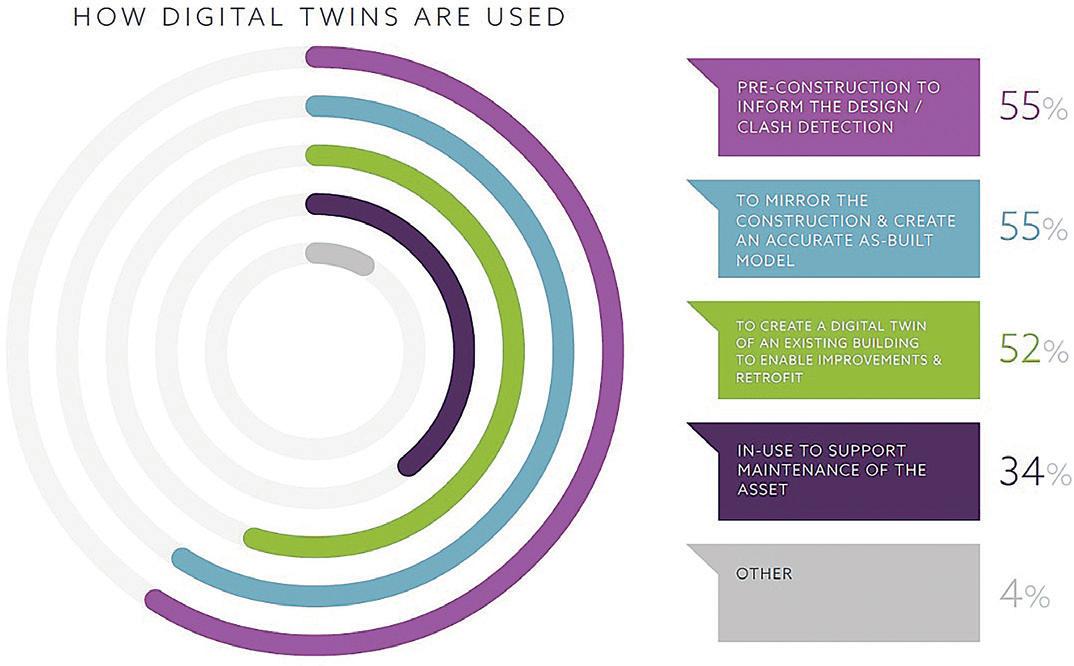
The study also flagged a growing appetite for the use of immersive technologies, such as Augmented Reality (AR), Virtual Reality (VR), and Mixed-Reality (MR) which are playing an increasinglyimportant role.
More than one in three professionals (36%) are already using this type of technology, and a further one in five (20%) plan to within the next three years.
Overwhelmingly, its main use is for stakeholder engagement (74%), where upcoming or ongoing projects can be digitally generated to present detailed plans.
However, for two in three users (62%), immersive tech offers a way to visualise design interfaces so they can better understand how construction projects fit within existing surroundings.
Just over a third (35%) use it for marketing purposes, particularly among suppliers (67%) who recognise its value when selling products and systems.
…we can see that construction is shaking off old and tired misconceptions and now relies on all manner of digital skills to produce building excellence
More than one in five (22%) have already adopted AI, and a similar number (20%) said they will do so within a year.
Eight in 10 now also use a form of cloud computing as part of their daily workflow.
While mainly in the form of storage, including Google Drive, OnePoll, DropBox, etc; the study revealed that over 70% use it to share documents and information with clients.
Three-quarters (75%) also use it to collaborate with other team members, particularly on 3D models and specifications.
And, given the industry’s push towards the Golden Thread and focus on digital information management, it shows the sector is making the essential investment to increase efficiency and reduce risk in the built environment.
A point of interest within the report was that despite overall growth in the use of technology, opinions on whether the industry is still lagging behind others remain divided.
Nearly half (47%) are still concerned the industry is behind the times when it comes to the adoption of digital technologies. But over a quarter believe it’s no longer the case.

Speaking on this year’s report, David Bain, research manager at NBS, said: “It is clear from the results that construction has ramped up digital adoption in recent years and is a far stride from where it was three years ago.
“Looking ahead, it will be fascinating to see next year’s report as 2024 is shaping up to be big on AI and machine learning.”
Russell Haworth, NBS chief executive, added: “Looking at the evidence, we can see that construction is shaking off old and tired misconceptions and now relies on all manner of digital skills to produce building excellence.
models.

Looking back to 2020, two in five (38%) said they were unsure if their organisation was using it, of those who did, just 9% were using AI.
Although the use of AI in construction is yet to take its grip (43% said they have no plans to use it), signs of early adopters are already visible.
“That said, there are still some areas for improvement and no doubt next year will bring further leaps in tech know-how and application.” n
723 construction professionals took part in this year’s Digital Construction Survey, which included views from architects/engineers and other consultants, contractors, clients, and suppliers in the UK and beyond. Previously known as the NBS BIM Report, the study is a benchmark for changing attitudes towards tech adoption and new technologies

In this article we look at how the concept of a ‘village campus’ is setting a benchmark for the future design of mental health units
PHOTOS: RICHARD CHIVERSSycamore at Northgate Park Hospital will play a vital role in the future delivery of modern and effective forensic mental health services in the North East of England.
Built by Sir Robert McAlpine and developed around the concept of a ‘village campus’, the new mediumsecure hospital at the heart of the £60m redevelopment of Northgate Park Hospital, provides a wide variety of indoor and outdoor settings for relaxation and activity, relieving boredom and addressing the risk of challenging behaviours and poor physical health.
Designed by Medical Architecture for NTW Solutions — Cumbria, Northumberland, Tyne and Wear NHS Foundation Trust — Sycamore is the catalyst to enable all secure services across the trust to be brought together from previously-dispersed sites, and consolidated in a single, integrated secure centre of excellence.

The entire redevelopment provides a total of 116 male inpatient beds, located in a combination of new and reconfigured existing buildings.
The new-build element, known as Sycamore, provides inpatient accommodation for 72 male patients with a range of forensic mental health needs, including patients with complex personality disorders and/or learning disabilities.
The project, which was delivered through Cohort 1 of the NHS New Hospital Programme, fulfils one of the trust’s key strategic priorities, forming part of its £72.6m Care Environment Development and Re-provision Programme (CEDAR).
The existing hospital site is a large open campus, containing a mix of buildings and facilities.
And much of the eastern portion, which was earmarked for development, is neighboured by a broad area of mature woodland.
Proposals set out to develop a portion of the land for the new building, with the remaining allocated for housing development. Early feasibility work demonstrated benefits to siting the new hospital where it would be flanked by an aspect of trees on three sides: the natural setting enhancing the therapeutic nature of the accommodation.
It is well recognised that in secure mental health inpatient units, boredom leads to challenging behaviours and poor physical health.
Therefore, a key driver for the design was to ensure a meaningful day for all patients, promoting recovery through activity.
As a result, the facility is devised as a ‘village campus’ focusing on the individual patient and staff experience, with as many spaces as possible, both inside and out, offering opportunities for mitigating boredom.
This is achieved in a range of settings that can be accessed autonomously, from bedrooms to living spaces, and sheltered gardens to open courtyards, with opportunities for both structured and unstructured sports and activities.
The six patient wards are paired together and arranged around a large recreation courtyard.
Each building is adjoined, creating a secure boundary without the need for fences, minimising the feeling of confinement.
With rich landscaping and integrated security measures, this shared space does

not feel like a typical forensic mental health facility.
And the courtyard is separated into two distinct character zones—‘Passive’ and ‘Active’ — to ensure patients and staff are able to benefit from its therapeutic qualities.
The ‘Passive’ zone provides opportunities for refuge, with restful places to sit among plants and grasses.
These smaller-scale spaces offer a sense of enclosure, combined with views out to the wider recreation area to provide gentle enticement into the activities offered.
The ‘Active’ zone includes a 200m jogging/walking loop, activity spaces, and
a fitness ‘trim trail’, to promote physical activity and the associated wellbeing benefits.
Within the main reception building — which provides the public frontage to the facility — a covered sports barn allows activities to continue in all weather conditions.
In addition to these communal spaces, at the centre of each ward, a private landscaped courtyard for relaxation is provided, and between each ward pair is a designated activity courtyard, with sports court markings.



The technical requirements for forensic mental health buildings, particularly with regards to security, can present challenges to the creation of supportive and recoveryfocused environments
This arrangement offers safe access to a variety of different outdoor areas.
In each ward, the bedrooms are arranged to face outwards, with views to the surrounding woodland.
And the majority of the day activity and living space is at the centre of the ward, with direct access into the courtyards.
Abundant daylighting, attractive views, and a sense of spaciousness contribute to the therapeutic qualities of the environment and play an important role in patient rehabilitation.
While use of the common spaces is actively encouraged, it was acknowledged that this patient group may choose to spend time in their own room, particularly in the morning and evening.
To maximise the opportunity for activity, the design of the bedrooms stemmed from a detailed re-imagining of how these spaces could work.
In an evolution of previous designs for the trust, the bespoke fitted furniture is devised to assist with a personal workout outside of scheduled recreation time.
Adequate floor space for exercise and a television which can be easily viewed from the bed or floor enables a patient to either be active or to rest.
The transition from private bedroom to
shared circulation and day spaces has been considered to provide a reassuring path into more-stimulating environments.
The bedroom corridors are single-sided, with immediate views to the landscaped ward courtyards from each bedroom door, providing orientation, good observation, and balancing circadian rhythms.
The exterior appearance of the new facility is extremely important and has a major role to play in reducing the stigma surrounding mental illness, as well as engendering pride in the building as a workplace.
The front reception building provides a secure boundary to a large section of the internal plan, reducing the need for high fencing.
And a visible and publicly-accessible café with integrated artwork provides a welcoming space for visitors and staff working across the site.
A consistent and controlled palette of materials and architectural styles has been developed to integrate the building with the most-recent additions to the hospital site and to present a positive image for visitors and new arrivals.
Paul Yeomans, director at Medical Architecture, said: “It is fantastic to see this important project realised.
“The technical requirements for forensic

mental health buildings, particularly with regards to security, can present challenges to the creation of supportive and recoveryfocused environments.
“However, standing in the thriving central courtyard, it is hard to tell you are in the middle of a forensic hospital.
“That normalising of the accommodation will have such a positive impact on patient wellbeing.”
John Carson, head of capital development at NTW Solutions, added: “This has been a fantastic scheme to deliver and there was a true team spirit with all involved, especially with the clinical teams on site.
“That teamwork has paid off and it is inspiring to see the unit in use and heartening to hear the early feedback from clinicians about the quality of the accommodation.
“This is a flagship development, and it has set a new standard, not just for our future projects, but for the whole mental health sector.” n



Retirement community developer, McCarthy Stone, has started work on its tenth MMC site in the last three years, with more in the pipeline, reflecting the increased use of offsite construction techniques within the health and care sectors
McCarthy Stone, the UK’s leading developer and manager of retirement communities, is driving forward its use of Modern Methods of Construction (MMC) and is set to start work on its tenth development to be built in full using this approach since 2021.
Once complete, it will deliver 473 specialist retirement properties, with more MMC schemes planned.
The announcement follows a recent letter from the chairman of the Built Environment Committee to the Government stating that the UK has so far failed to build MMC homes in meaningful numbers, and shows how the issues the committee raises can be overcome.
FASTER AND GREENER
As a national first for a UK developer, McCarthy Stone has a partnership with Remagin — formerly Sigmat — Europe’s leading manufacturer of panelised
MMC is helping us to further increase our build quality, control our costs, and, most importantly, build more energy-efficient and greener communities
structural steel frames, to use its ecofriendly Light Gauge Steel Frame (LGSF) MMC solution, where the panels are built in a factory and then assembled onsite, helping it to build faster, greener, and more affordably.
Three schemes are already complete and open and four more will complete by the end of this year, with a further three due to start on site shortly.
The first scheme, in Hexham, opened in 2021 and was delivered significantly faster than traditionally-constructed sites, saving around 15% in time, despite adverse weather conditions.
And it was completed with half the number of defects expected to be found on a traditional scheme.
More-recent schemes have saved around 20% in build time.

Our focused approach to MMC, and our secure pipeline of consented land, means we have found the right formula to enable us to use it to accelerate housing delivery
McCarthy Stone and Remagin have also evolved their approach over recent years, with windows, external doors, and external insulation now also fitted in the factory, further reducing risks and delays.
Future developments will also progressively incorporate a streamlined closed panel solution to maximise the benefits of MMC.
Peter Forsyth, director of strategic initiatives at McCarthy Stone, said: “We’ve had plenty of success with MMC thanks to our partnership with Remagin.
“MMC is helping us to further increase our build quality, control our costs, and, most importantly, build more energyefficient and greener communities.
“Our focused approach to MMC, and our secure pipeline of consented land, means we have found the right formula to enable us to use it to accelerate housing delivery.
“MMC is now becoming a key component of our development pipeline.”
David Bridges, chief investment officer at Homes England, added: “Having an established pipeline of projects is absolutely crucial for the MMC sector to grow, so it’s great to see McCarthy Stone’s continued commitment to delivering multiple MMC schemes.
“We’re involved in the scheme at Failsworth, which is set to complete this year, as well as Erdington, Bradford, and Huyton, all of which are expected to commence construction shortly.”
And Scott Bibby, country manager for Ireland & UK at Remagin, said: “Despite recent adverse media publicity about MMC, Remagin’s partnership with


McCarthy Stone proves that, with the right collaborative approach, MMC is still very much a solution to the challenges of today’s housing market.
“Through partnering together, we have been able to develop and fine-tune a highlyenergy-efficient product which delivers speed, quality, and consistency of build, while also addressing cost and affordability
“The future of our partnership looks exciting.”
McCarthy Stone has also written to the Housing Minister to note how the use of MMC could be deployed successfully across the later living sector, including setting specific targets, aggregating demand, aligning supplier solutions by using a standard ‘chassis’ approach, and investing in qualification and regulation frameworks to create simple standards and approval


How making improvements to medical gas supplies can help hospitals to reduce their carbon footprint
Charing Cross Hospital is one of only a handful of major hospitals in England to decommission its entire nitrous oxide manifold in one go — reducing carbon emissions by more than 460 tonnes a year.
Nitrous oxide has been used for over 175 years as part of anaesthesia within healthcare, but it is a potent greenhouse gas, estimated to be nearly 300 times worse than carbon dioxide for the environment.
And recent research revealed a significant proportion of emissions at older NHS hospitals like Charing Cross is due to waste from manifolds and the associated old pipe structure.
Speaking to Healthcare Property, Dr Tom Dolphin, a consultant anaesthetist at Imperial College Healthcare NHS Trust, which runs Charing Cross, explains: “Nitrous oxide is a key contributor to trusts’ carbon footprints.
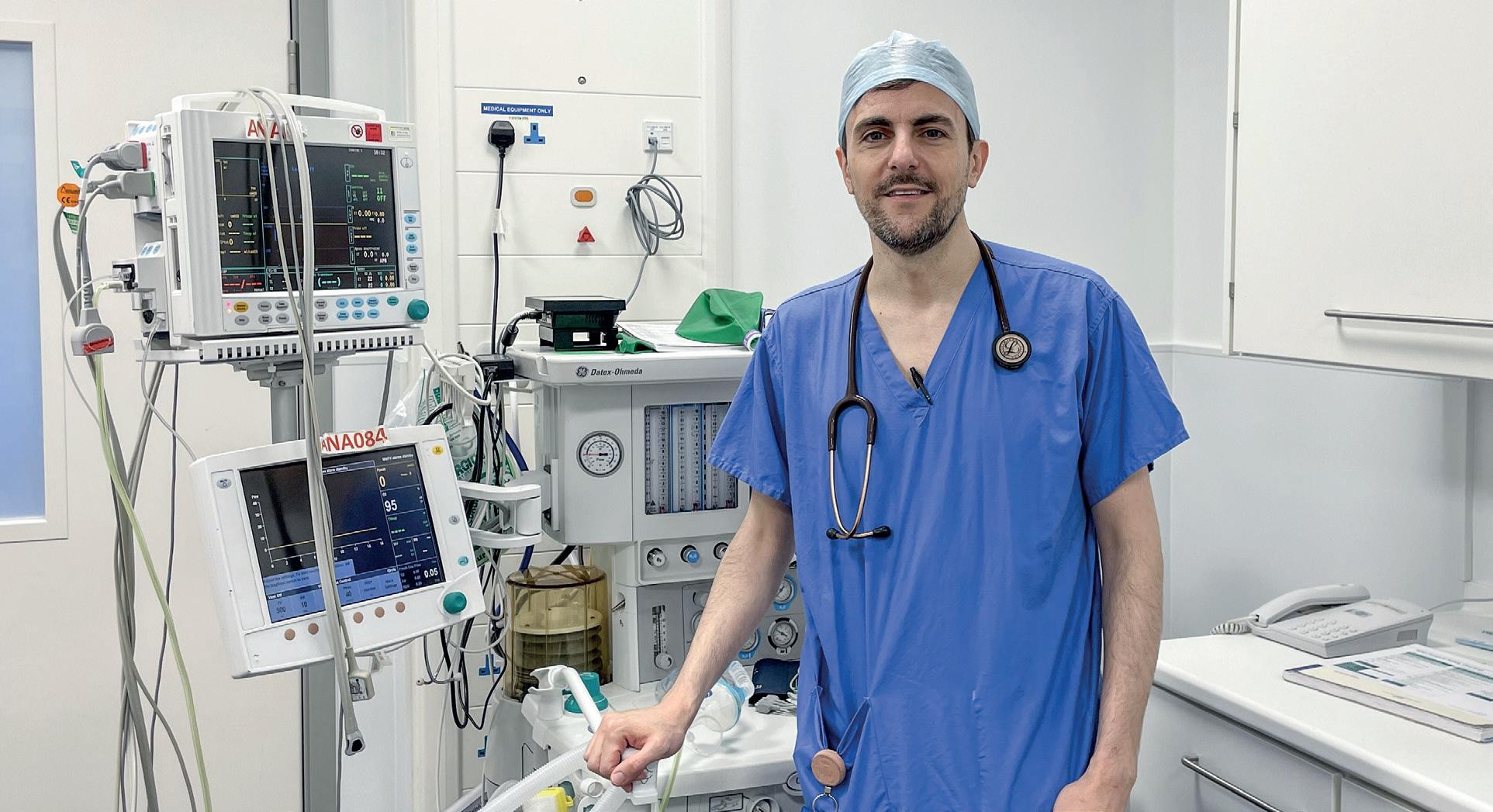

“But, when we compared the number of empty cylinders with clinical use from our digitised anaesthetics records, we realised that the number of cases every month where it was being used clinically, and how many litres that represented, was far lower than the amount of gas we were piping through the system.

“We did various checks and confirmed our suspicions that almost all of our usage was in fact leaks at various points along the ageing pipework system.
“While the leaks did not pose a health risk, they were bad for the environment.”
Working with medical gas specialist, SHJ, the trust had three options: Stop providing nitrous oxide altogether and turn off the supply; attempt to repair the whole nitrous oxide pipework system; or decommission the manifold and replace it with a new supply system located much nearer to the few areas where it is still used.
Dolphin said: “There is still a need to provide nitrous oxide for the very-few clinical situations where it is used, and repairing and replacing pipework right across the building — across 14 storeys of a 50 to 60-year-building — would be a major undertaking.
We are one of the biggest NHS trusts in the country, with an ageing estate, and are absolutely committed to reducing our impact on the environment and reaching carbon net zero before 2045
“Instead, we chose the third option.
“This meant manually turning a lever to cut the flow from the cylinders, sending them back to the British Oxygen Company, and then capping off the outlets at the point of use with end blanking plates to make it clear they are no longer in use.”
However, getting buy-in from the various departments was a much-longer process.
“What I underestimated was the sheer number of people involved in a decision like this,” said Dolphin.
“The majority of the work was governance.
We had to involve the medical gases committee, pharmacy, portering, estates and facilities, anaesthetists — a lot of people were involved, and we needed to get buy in from them all and understand their concerns.
“While the physical work is relatively minimal, what really took time was making sure we spoke to all the right people.”
But, having now completed the work, the results are already being realised.
It is estimated the move will reduce greenhouse gas emissions by at least 460 tonnes of C02e (carbon dioxide equivalent) a year — around 1% of the trust’s overall carbon footprint.

This saving is estimated to be the equivalent of driving a petrol car around the earth 57 times.
Dr Bob Klaber, director of strategy, research, and innovation at Imperial College Healthcare NHS Trust, said: “This is a really-innovative and impactful project and I am grateful to the many teams who worked so hard over the past six months to make it possible.
“We are one of the biggest NHS trusts in the country, with an ageing estate, and are absolutely committed to reducing our
impact on the environment and reaching carbon net zero before 2045.”
The trust is now looking more widely at its use of anaesthetic gases to identify additional areas for improvement.
The includes the trialling of volatile capture technology (VCT) canisters designed to capture anaesthetic gases at Charing Cross, Hammersmith, and St Mary’s hospitals, as part of a large-scale feasibility trial funded by Imperial Health Charity to reduce carbon emissions in surgery.
The canisters are designed to capture significant volumes of the exhaled anaesthetic gases, which can then be
Decommissioning of the nitrous oxide piping system and manifold has also taken place at hospitals in Gwent as part of carbon-cutting efforts by Aneurin Bevan University Health Board.
A project carried out by the clinical workstream of the health board’s Decarbonisation Programme Board found there was significant wastage secondary to small leaks in the ageing pipelines and out-of-date gas cylinders.
Dr Jenna Stevens, a consultant anaesthetist, sustainability lead, and clinical lead for the decarbonisation board, said: “The clinical use of nitrous oxide over the last 10-15 years has dramatically reduced.
“What we were finding was that even though our use had declined, we were still purchasing a significant quantity of nitrous oxide.”
There are currently around 90 anaesthetic machines across our hospitals, with thousands of anaesthetics given each year to patients, so making this change would be a significant step in reducing our carbon footprint
purified and reused.
And the team will use the findings from the trial to make a case to roll this out permanently across the trust.
Dolphin said: “There are currently around 90 anaesthetic machines across our hospitals, with thousands of anaesthetics given each year to patients, so making this change would be a significant step in reducing our carbon footprint.” n

As part of the project, the team has been able to decommission systems at Ysbyty Ystrad Fawr, Nevill Hall Hospital, St Woolos Hospital and Royal Gwent Hospital. Smaller, more mobile cylinders are now in place at all of these sites, providing the gas where necessary and reducing emissions and waste.
Financially, this represents a saving of £14,500 per year. But its environmental impact is much greater, estimated at 900 tonnes of carbon dioxide equivalent and equating to over 2.2 million miles driven by a car.
The team now plans to look at ways to reduce the impact of Entonox wastage.






How Green Plans are underpinning every NHS trust’s carbon reduction efforts
In October 2020, the Greener NHS National Programme published its new strategy, Delivering a net zero National Health Service
The report highlighted that, left unabated, climate change will disrupt care, with poor environmental health contributing to major diseases, including cardiac problems, asthma, and cancer.
And it set out trajectories and actions for the entire NHS to reach net zero carbon emissions by 2040 for the emissions it controls directly, and 2045 for those it can influence, such as those embedded within the supply chain.
To support the co-ordination of carbon reduction efforts across the NHS and the translation of this national strategy to the local level, the 2021/22 NHS Standard Contract set out the requirement for trusts to develop a Green Plan to detail their approaches to reducing their emissions in line with the national trajectories.
And, given the pivotal role that integrated care systems (ICSs) play, this has since been expanded to include the expectation that each system develops its own Green Plan based on the strategies of
Our Green Plan is our commitment to reduce our impact on the environment and put us on a path to deliver a cleaner, greener, healthier, and more-equitable future
its member organisations.
Here, we look at how one trust has approached this and the support available.
“Our Green Plan is our commitment to reduce our impact on the environment and put us on a path to deliver a cleaner, greener, healthier, and more-equitable future,” said Stacey Hunter, chief executive of Salisbury NHS Foundation Trust.
The trust, which runs Salisbury District Hospital, delivers a broad range of clinical services to approximately 270,000 people
in Wiltshire, Dorset, and Hampshire, including specialist services such as burns, plastic surgery, cleft lip and palate, and rehabilitation, while the Wessex Regional Genetics Laboratory extends to a muchwider population of more than three million.
Salisbury District Hospital also includes the Duke of Cornwall Spinal Treatment Centre, a purpose-built, 45-bed unit which specialises in caring for people who have spinal cord injury and serves a population of 11 million covering an area across most of southern England.
Services are delivered by 4,800 staff and the estate covers some 21 hectares, with a large proportion of services housed in older accommodation.
To address the carbon emissions associated with these services, and the buildings from which they are delivered, the trust’s Green Plan focuses on nine key areas:
• Adaptation
• Travel and transport
• Workforce and leadership
• Medicine and gases
• Sustainable models of care
• Supply chain
• Estates and facilities
• Digital transformation
• Food and nutrition
The 17-page document sets out 14 key priorities, and many of these are estates and facilities driven, including developing mitigation and adaptation plans in response to climate change, promoting and investing in energy and water-saving measures, ensuring modern building methods are applied to new building projects, and reducing the volumes of residual waste through supplier engagement, avoidance, reuse, and recycling.
The estates section of the plan lays out some of the interventions which have already been deployed, including the appointment of an energy conservation manager; investment in solar panels, which now generate 4% of the trust’s electricity; installation of combined heat and power (CHP) technology, providing 40% of the onsite electricity demand; LED lighting upgrades; and the development of a recycling centre.
And, with an ambition to ‘make every kWh count’, the trust outlines another 13 steps it will take by the end of this year.
These include reducing water loss (leaks) and investigating the opportunity to recycle water in it swimming pools; developing plans for the transition to more-efficient lighting and preparing buildings for electricity-led heating; further embracing modern methods of construction; replacing inefficient infrastructure and buildings; and preparing the estate for severe weather events.
The report states: “Achieving NHS carbon reduction targets will require new hospitals and buildings to be, at the very least, net zero carbon compatible.
“We are committed to the delivery of NHS carbon net zero objectives and our ‘campus development’ programme will make a significant contribution to achieving this commitment.
“It will enable us to move out of old, inefficient buildings and facilitate the

Achieving NHS carbon reduction targets will require new hospitals and buildings to be, at the very least, net zero carbon compatible



• Develop and refine SMART (specific, measurable, achievable, relevant and timebound) actions focused on early efforts to directly reduce carbon emissions
• Develop systems and processes to measure and report on progress against plans and commitments annually And it says that development of the plans should be led by a designated board-level net-zero lead, which ‘should generally be one of the existing executive directors’.
The guidance states: “The plan will require senior, expert input from a broad range of disciplines and functions, including clinicians, estates and facilities, procurement, finance, and human resources.
“These senior individuals should also be informed by vibrant, representative, and well-supported sustainability groups and networks drawn from a wide range of staff across each NHS organisation or ICS.
“Progress against an approved Green Plan should be formally reported annually to the trust board or ICS governing body and progress reported formally to the relevant regional greener NHS team, in a format and frequency agreed with them.”
But key to any plan is being able to effectively and accurately track and report progress.
The guidance states that new data collection methods are being developed
The plan will require senior, expert input from a broad range of disciplines and functions, including clinicians, estates and facilities, procurement, finance, and human resources
to enable the more-granular calculation of carbon footprints at regional, ICS, and trust level, with The Greener NHS Data Collection launched in April 2021 to understand actions that are taking place and provide a baseline from which progress can be understood.
A number of other resources have also been made available, including the Greener NHS Dashboard and Health Outcomes of Travel Tool.
And, while it states that most interventions will be cost neutral or provide an immediate cost benefit, it recognises that additional capital investment may be needed.
It adds: “In developing a Green Plan, organisations should consider how net zero principles can be routinely integrated
into all business-as-usual upgrades and maintenance.
“This may facilitate the use of funding set aside for backlog maintenance to be deployed more effectively to reduce future costs and carbon emissions, while improving resilience to the local effects of climate change.
“Beyond this, sources of additional funding to support the UK-wide move to net zero enshrined in the Climate Change Act are increasingly forthcoming.”
Recent examples of additional funding made available to NHS trusts include the £50m NHS Energy Efficiency Fund for LED lighting and a number of awards under the Government’s public sector decarbonisation scheme, which is now in its third phase. n

Thirteen health centres in Hull are becoming some of the most sustainable medical facilities in the country, thanks in part to an ambitious programme of lighting replacement.
Healthcare estates management company, Hull Citycare, has been working with Sewell Facilities Management across its 13 health centres in the city to replace almost 7,000 light fittings with low-energy LEDs, dramatically reducing energy usage and costs and lessening their carbon footprint.
The project is being funded and operated through the NHS Local Improvement Finance Trust (LIFT) programme, and, as well as using less energy, the LEDs are brighter than standard compact fluorescent lighting, providing cost savings and lasting up to 10 years — 10 times longer than a normal light bulb.
The final light of the programme was recently fitted by Sewell FM technician, Andy Richardson, at Elliott Chappell Health Centre, making Hull the only city to have all its health centres fully fitted with LEDs. Community Health Partnerships (CHP) is the head tenant at 308 healthcare buildings, built under the LIFT programme in England.
And so far 24 of its buildings are fully LED lit, with 13 of those in Hull, making the city a leader in energy-efficient lighting.
The scheme, which has taken two years to complete, was started when Sewell FM wanted to find a new way to help Hull Citycare save time, money, and energy.
Sean Henderson, managing director of Sewell FM, who manages building maintenance for the health centres, said: “Decarbonisation is at the top of everyone’s priority list at the moment, so when Sewell Facilities Management came to us saying they could reduce energy consumption and also save money, it seemed like a win-win situation.
“It is already saving the health centres thousands of pounds every year, which is money that can be spent on clinical services and making the health centres even better for patients.”
Tim Wigglesworth, chief executive of Hull Citycare, added: “Our primary and community buildings are crucial healthcare estate, aligning to the NHS net zero ambitions.
“The stainability agenda is a key driver for CHP and we understand the importance of
this to our tenants.
“Being able to deliver sustainable facilities and value for money has never been so important and we are delighted that 100% of Hull Citycare buildings now have LED lights — resulting in significant environmental and financial savings across the health system.”
Changing a traditional lightbulb in a health centre is not easy as you need to close off the space, put up barriers, and sometimes even bring in mobile elevating working platforms to reach fittings in higher and difficult-to-reach areas.
This causes disruption for building users and staff, takes facilities teams away from urgent jobs, and then, a year or so after you have put the new lightbulb in, they need replacing again.
After trialling LEDs at Bilton Health Centre, the team knew the benefits that moving to LEDs would bring for the buildings, patients, and staff, so agreed to pay for and fit the new lights to all the health centres.
The buildings now have much-longerlasting lights that do not need changing every year, freeing up estates teams to carry out more-important works.


Health board announces expansion of the country’s first hospital solar farm
In 2021 Morriston Hospital became the first hospital in Wales to develop a solar farm, which has been successful in cutting Swansea Bay University Health Board’s carbon emissions by 1,933 tonnes a year.
And now work has begun on a new £3.6m solar extension and battery energy storage system (BESS) project which will deliver another 1MW of clean energy.
The new BESS will allow for the energy created during the daytime to be used after sunset, enabling more of the electricity generated to be used by the hospital.
In addition to the carbon savings, the solar farm and extension are expected to save over £1.2m in energy costs per year.
Des Keighan, the health board’s assistant director of estates, said: “The solar farm has been a huge success in the two years it has been operational, and the savings in finances and energy prove that.
“As a healthcare provider it is important we respond to our obligation to protect health, the environment, and public finances.
“Those two factors are really important and our savings coincide with the rising costs of electricity, and in terms of carbon emissions it is at a time when it is more important than ever to look after our environment.
“As a health board, we are determined to continue reducing our carbon footprint, and the solar farm has helped us enormously in that respect.”
The additional 1MW will increase the overall generation of power to 5MW — an extra 1,000,000 kWh per year — taking the total expected annual generation to five million kWh.
The total demand for the hospital is close to 15m kWh per year.
The solar extension and BESS are expected to generate a third of Morriston Hospital’s power and make an additional annual saving of around £325,000 to the £900,000 already being saved each year on electricity costs.
Until now, the solar farm has provided around a quarter of the hospital’s electricity needs.
As a health board, we are determined to continue reducing our carbon footprint, and the solar farm has helped us enormously in that respect
Beverley Radford, estates programme manager, said: “The combined effect of both of these systems will be to further reduce reliance on grid electricity at Morriston, with a corresponding additional saving of around £325,000 a year, plus helping to insulate the health board from volatile and generally-increasing future energy costs.


“We saw unprecedented swings in electricity prices and energy prices generally caused by global geopolitical factors outside of our control in 2022 and last year. And it was this backdrop of spiralling energy prices which led to the increase in generation capacity and the addition of the battery to our solar farm, together with the health board’s commitment to reduce carbon emissions to net zero by 2030.
“During this time, there were occasions when the solar generated more power than the hospital needed, so the electricity was sold back to the grid.
“The price of that has doubled within two years, which has impacted on the viability of the farm and is one of the
reasons it is now possible to expand.”
This latest phase is expected to be fully operational by April.
It is the first solar farm in the UK to directly power a hospital and has already delivered a cost-avoidance of £1.8m in electricity bills since being switched on two years ago by generating its own power instead of the health board purchasing it from the grid.
The farm initially cost £5.7m, with this extension costing £3.6m — repayable over 11 years and funded by an invest-to-save grant from the Welsh Government’s Wales Funding Programme.
Scott Lutton, operations director for industry partner, Vital Energi, said:
Vital Energi is working with NHS Forth Valley on a multi-technology project to improve energy efficiency, reduce carbon emissions, and support delivery of the board’s net-zero targets.
Work will include the installation of more-thermally-efficient glazing, roofmounted solar, insulation, LED lighting, BMS infrastructure, and electric boilers.
Financial savings from the improvements are expecting to be around £59,000 a year, utilising a blend of energy conservation measures tailored to the board’s shortlisted buildings.
Lifetime carbon savings are anticipated to reach 1,595 tonnes of carbon dioxide and the scope developed in this phase creates a pathway for further carbon reduction solutions to be implemented in the future.
Kieran Walsh, Vital Energi’s operations manager for the North and Scotland, said:

“We have seen from previous projects with the NHS that there is scope to provide innovation to the way health boards generate and consume energy, reducing both their carbon footprint and energy bills.
“NHS Forth Valley is taking a significant step towards its net-zero goals by harnessing a mixture of technologies that capitalise on energy and carbon reduction

approach towards decarbonisation.
“It has a long-term plan, with a clear strategy of how it will reach net zero and we are delighted to be able to work alongside the board to deliver this.
“By focusing on energy reduction first, then creating a solar farm and decarbonising its heating infrastructure, the board has demonstrated how a phased approach can yield strong decarbonisation and we believe it is a role model for public sector organisations which need to meet their net zero targets.”
Work is already in progress on the upgrade, with over 1,800 new panels being constructed, taking the total to 11,836. n
opportunities across the estate and we are delighted to be assisting them on their journey.”
Almost £2m of funding from the Green Public Sector Estate De-Carbonisation Scheme will be used to improve the energy efficiency across 13 sites, representing over 12,000sq m of floorspace.
Derek Jarvie, NHS Forth Valley’s head of climate change and sustainability, said: “Increasing the energy efficiency of local healthcare facilities across Forth Valley is a key priority as this will not only cut energy bills and generate income, but will also help reduce carbon emissions.
“This work is just one of a wide range of initiatives underway to reduce waste, use more-environmentally-friendly products, and deliver greener, more-sustainable services in our efforts to achieve net-zero emissions by 2040.”

George Emms, specification sales leader at Polyrey, part of Wilsonart UK, explains the key considerations when specifying surface materials for the modern healthcare estate
The primary function of the healthcare estate is to improve patient outcomes.
And all design, wherever possible, should be geared towards this aim — providing care and comfort in an environment that is effective, safe, and operationally efficient.
Each aspect of a modern built environment contributes towards this, whether directly or indirectly.
Indeed, beyond the clinical aspect, it is important for patients and providers alike to be in a comfortable and convenient setting if the best outcomes are to be achieved.
Engineered surfaces such as melaminefaced chipboard (MFC), high-pressure laminate (HPL), and compact laminate, are key to this.
Beyond intangibles such as developing trust and comfort through high-quality
aesthetics in public spaces, a hospital’s décor must match form with function.
This includes acting as a safeguard against the risk of infectious agents and healthcare-
for specifiers working on healthcare projects.
Yet there are important nuances and details to be discerned when discussing surface hygiene and specification in the hospital environment.
From the waiting room to the operating theatre, all surface coverings used in healthcare must meet rigorous standards around cleanability and durability.
Hospitals are demanding places with unique stresses and strains that every aspect of the modern built environment must consider beyond the clinical aspects of patient visits.
It is with this in mind that the area of
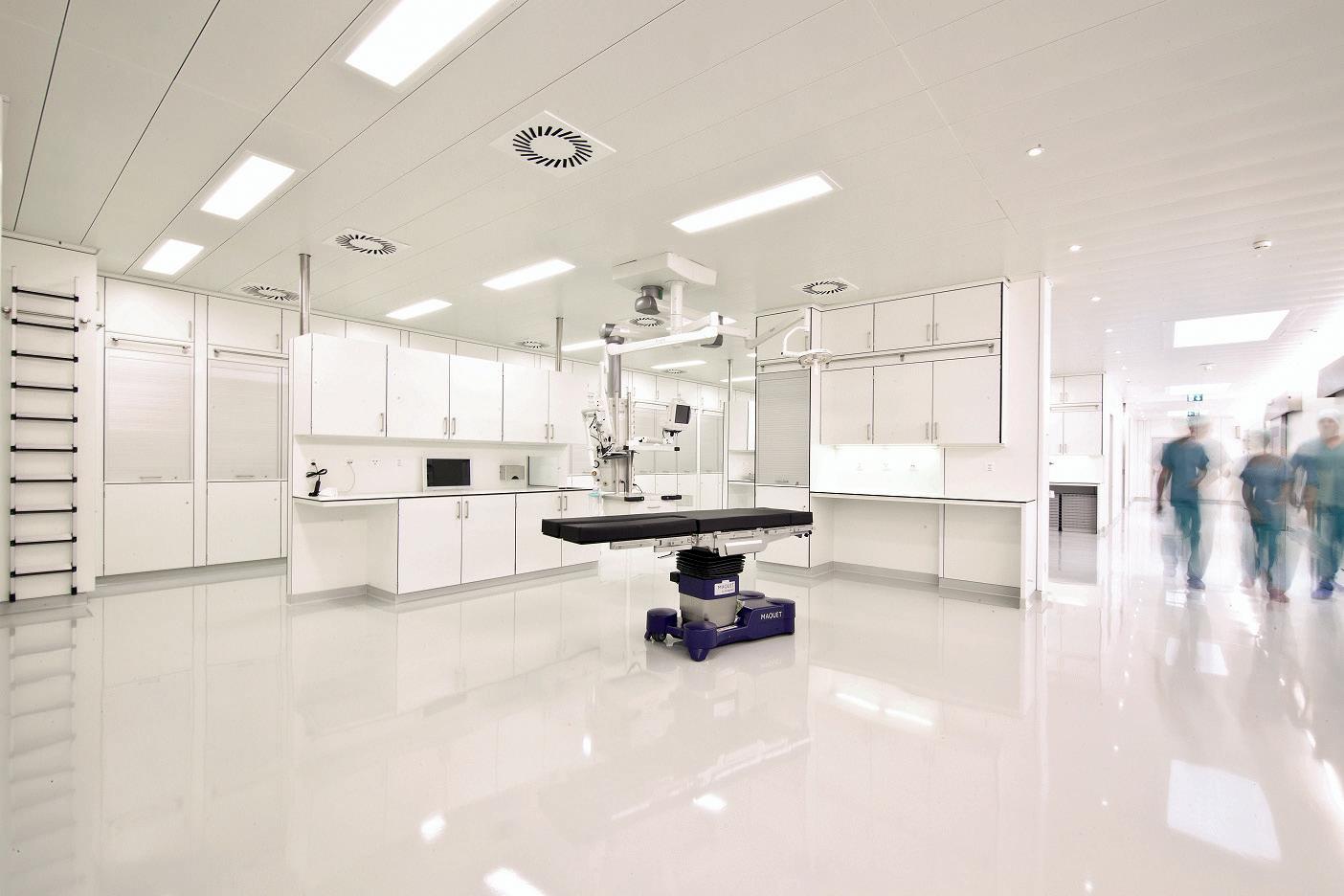
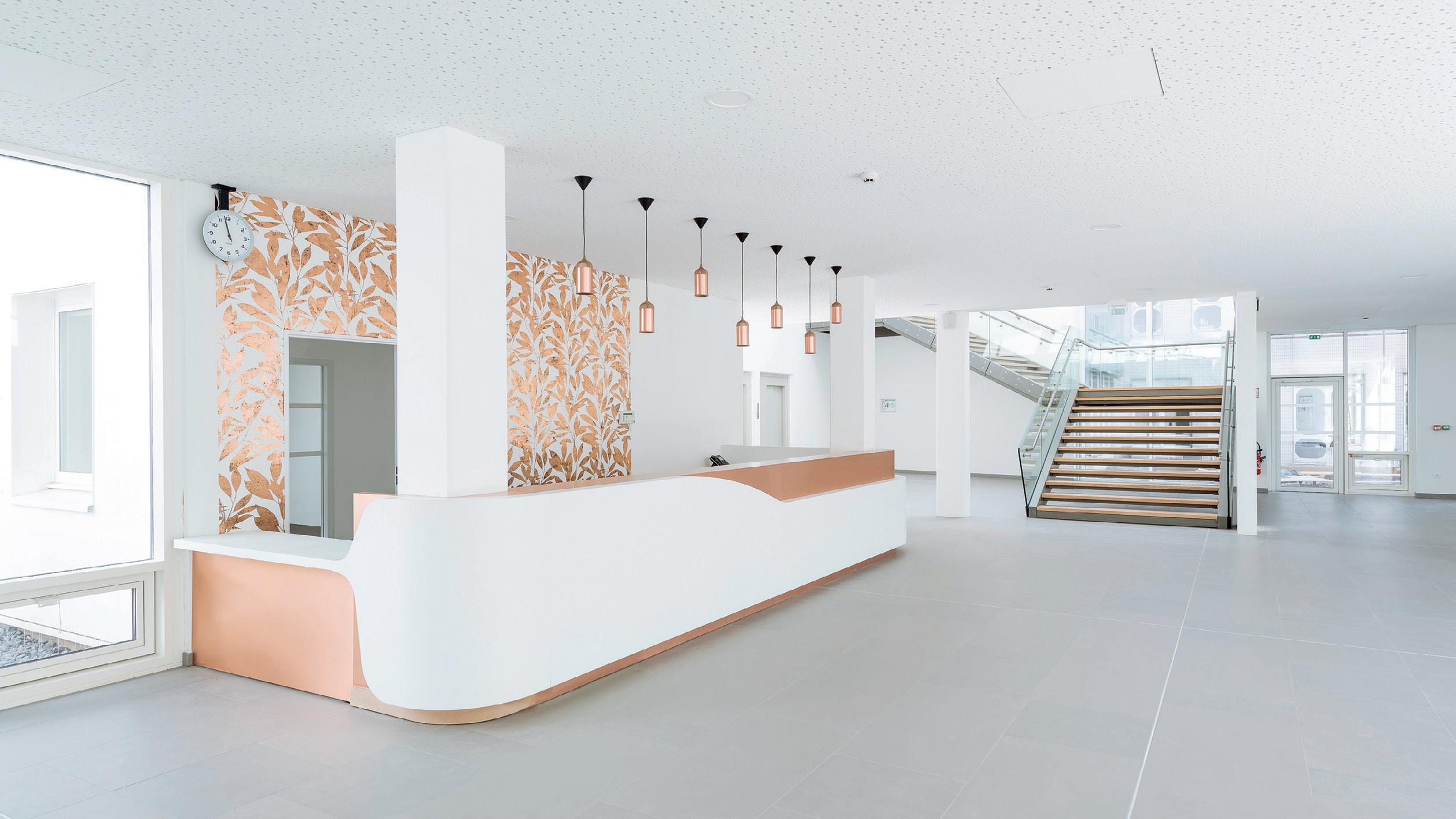
Currently, all surfaces must be selected with hygiene management and the prevention of bacterial proliferation in mind. This includes ensuring any specified products are hard-wearing without requiring additional protective coatings such as varnish or paint and that they are easy to maintain.
Given the requisite emphasis on cleanliness in hospitals, prioritising surfaces resistant to a large variety of sanitation procedures is vital.
For example, they must be able to withstand intensive cleaning procedures such as bio cleaning or disinfection with hydrogen peroxide, while also being resistant to a large variety of cleaning products.
However, this should be considered as standard.
Considering the renewed focus on cleanliness following the COVID-19 pandemic, it can be argued that healthcare estate specifiers should look to exceed current expectations, especially where hygiene is concerned.
From here, an important distinction must be made between coverings that are classed as ‘hygienic’ and those designated ‘antibacterial’.
Specifically, while the former passively limits bacterial proliferation; the latter actively assists toward this aim.
Importantly for specifiers, while all laminate surfaces will generally be considered hygienic, not every type of surface can be classed as antibacterial.
Whether used in a decorative or technical context, antibacterial laminate panels are designed to destroy 99.9% of bacteria within 24 hours.
This is made possible due to enhanced
silver ion protection being integrated into the material during the resin impregnation stage of the manufacturing process.
Consequently, this benefit is enmeshed within the product, meaning its effect will not deteriorate over time due to expected wear and tear within the hospital environment.
When complemented with the rigorous cleaning practices expected in healthcare estates, antibacterial panels can provide an important marginal gain toward infection control and patient safety that more-basic laminate panels cannot.
These solutions are currently only offered by Polyrey due to its work with SANITIZED AG, a leading producer of antimicrobial hygiene function and material protection for textiles and polymers.
To ensure the continued effectiveness of its antimicrobial protection technology, SANITIZED AG’s performance certificate is renewed every year following rigorous laboratory testing, further ensuring peaceof-mind for hospital stakeholders.
This innovation has been integrated into Polyrey’s in-house processes to ensure antibacterial grade products including MFC, HPL, and compact laminate are included as standard without additional costs or manufacturing delays.
And it is certified as food safe, skin safe, and when combined with the properties of water-repellent laminate materials, prevents moulds and bacteria from proliferating.
Additionally, the silver ions used within the material are not soluble, non-migratory, non-allergen, and do not lead to respiratory effects, so are not dangerous for patients or the healthcare environment.
As a result, surface cleanliness can be enhanced and HCAI risks mitigated.

It is important to note that though antibacterial materials are currently widely used across the healthcare sector, there remains no identifiable standard across Europe governing the time in which bacteria is killed off.
And this lack of a centralised knowledge resource may lead to information gaps when specifying in the hospital setting.
As a result, the sector must continue to adapt its working practices to avoid such pitfalls.
The supply chain has a key role to play in this, and it is advised that project stakeholders leverage their expertise — and that of their suppliers — in all aspects of the build, from the clinical to the environmental.
With patient protection paramount to hospital design, antibacterial surfaces are absolutely a part of this.
The guidance of manufacturers may therefore be instrumental in ensuring bacterial proliferation does not occur in all areas of the healthcare estate.
For healthcare architects or specifiers keen to explore the selection process more formally, the company offers a suite of RIBA-accredited CPDs.
This includes Everything You Wanted to Know about Decorative Panels and Engineered Surfaces, Waterproof Laminate Panelling Systems: A Viable Alternative to Tile, and The Changing Face of Performance Wall Surfaces as an Alternative to Tiles n

We look at how fencing designs for health and care settings have evolved to strike a balance between the need for safety and security and the desire to create more-therapeutic, lessinstitutional environments
Building design is critical in healthcare settings, providing the optimal environment for staff to deliver care and for patients to recover.
And, while landscaping and access to, and views of, nature have more recently become intrinsic to overall design approaches, one element often overlooked is fencing.
However, this is a crucial consideration as it not only protects sensitive medical equipment and maintains privacy and dignity, but it also helps to control access and prevent unauthorised entry.
Recent years have witnessed a strategic evolution influenced by government directives and consulting expertise, leading to a diversification in fencing strategies.
And one prominent trend reported by manufacturers is the

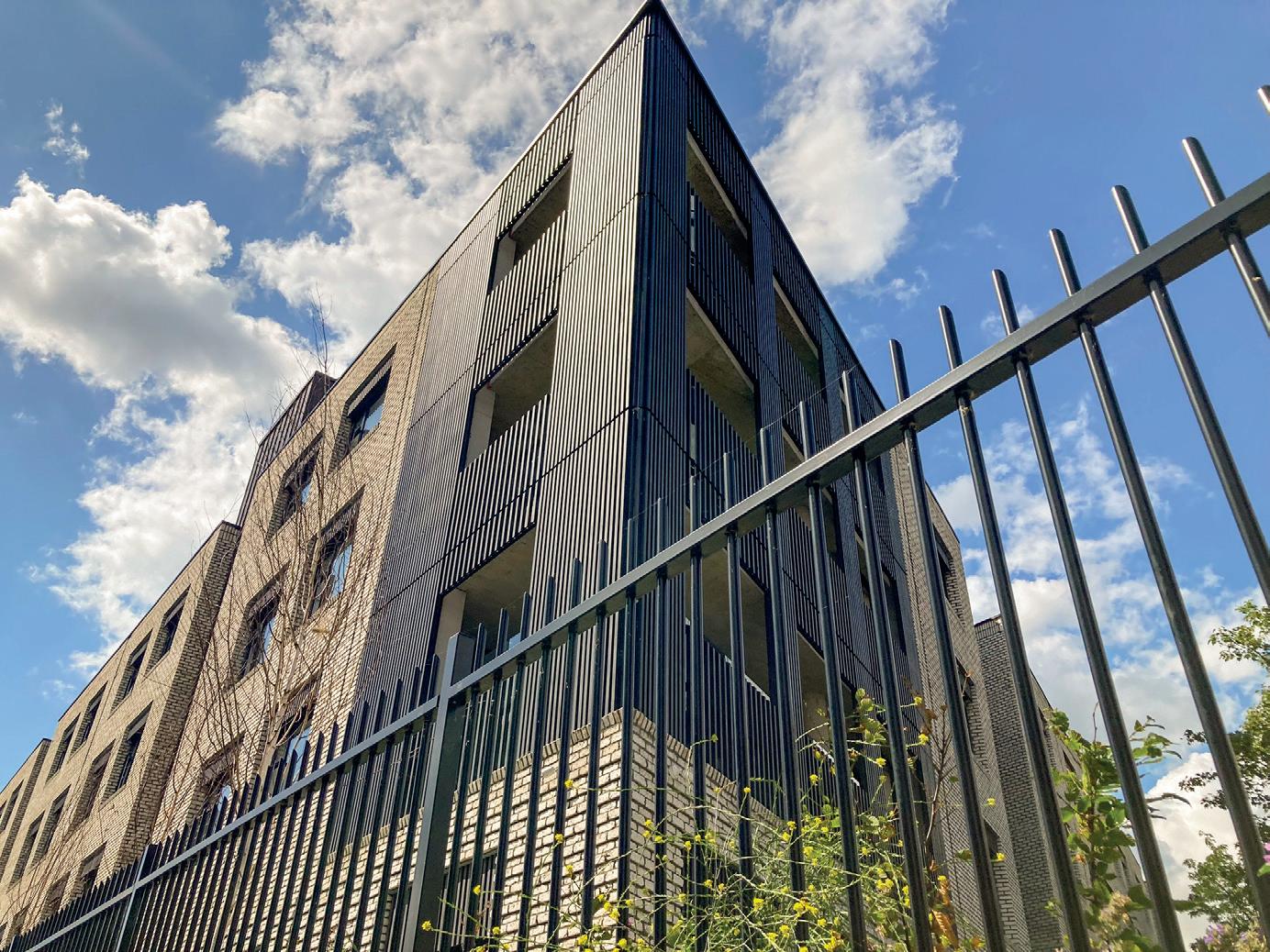

1. Vertical bar fencing creates a boundary fence
2. Bi-Folding Speed Gate for rapid access
3. Mesh fencing with tamper-proof fixings prevents vandalism
4. Acoustic Barriers reduce noise around fans and air conditioning units while keeping them secure
5. EuroGuard Combi safely secures waste and keeps it out of sight
6. Bollards segregate vehicles and pedestrians
7. Traffic barriers enable paid access control for visitors and access only for staff
8. Timber fence panels create a secure and tranquil recovery garden


Gates and entrances should be designed to accommodate wheelchairs,
stretchers,
and other medical equipment, and at the same time, the whole security strategy should present a welcoming aesthetic conducive to healing rather than hostility
adoption of fencing solutions that not only enhance security, but also offer additional benefits.
For instance, there is a growing emphasis on fences that provide both security and visual concealment, ensuring privacy while safeguarding property.
Peter Jackson, managing director of Jacksons Fencing, explains: “When specifying fencing for health and care environments, several key considerations must be taken into account to ensure the safety, security, and wellbeing of patients, staff, and visitors.
“The primary consideration is ensuring the fencing provides a secure boundary to prevent unauthorised access; fencing should be robust and resistant to tampering or climbing. But it should not hinder access for emergency services, staff, or individuals with mobility challenges.
“Gates and entrances should be designed to accommodate wheelchairs, stretchers, and other medical equipment, and at the same time, the whole security strategy should present a welcoming aesthetic conducive to healing rather than hostility.”
He advises opting for fencing designs that allow for clear visibility, both inside and outside the facility, for effective surveillance and monitoring.


protect confidentiality and maintain dignity, particularly around recovery gardens, critical care units, and sensitive locations where there is a view through windows or doors,” he adds.
“A design that can hide clinical waste should also be specified around waste areas and the layout of the facility should be carefully mapped to implement correct placement of suitable fencing to balance visibility and privacy across the site.
“Specifiers should select materials that are durable, weather-resistant, and low
barriers to prevent accidental injuries or unauthorised access.”
Acoustic fencing ranges, in particular, have grown in popularity within health and care settings.
Jackson said: “Rather than settling for conventional security measures, stakeholders are recognising the value of fences designed to mitigate noise pollution from sources such as air conditioning units.
“By opting for fences that serve multiple


Walking out into an external space where you aren’t just faced with an expanse of institutional grey fencing is far more preferable and much more therapeutic
“For example, installing a timber acoustic fence that not only deters unauthorised access, but also reduces noise levels from machinery like air conditioning units, is not just a practical choice, but also an aesthetically-pleasing one.
“The evolution of fencing reflects a strategic shift towards solutions that optimise security, functionality, and aesthetics.”
One area of the healthcare sector where fencing is key is within psychiatric facilities,
to mental health and mental health facilities.
“Many people still picture scary fortresses with barbed wire, rather than state-of-theart medical facilities, but modern solutions are a far cry from the days of barbed wire.
“Fence height, post details, and gating are all important to prevent escape and any personal damage, but the overall look also needs to be in keeping with a harmonious aesthetic that is congruent to promoting good mental health.”
Britplas is a leader in the field of mental health fencing — having launched its Fortress Fencing range in direct response to requests from a mental health trust in Manchester.
The product features an innovative cloaking system which makes the fencing anti-climb as well as preventing the passing of unauthorised items through the mesh.
And artworks can be applied to the cloaking to enhance the environment, creating attractive vistas which are aesthetically appealing and calming, while also minimising the fencing’s physical presence, adhering to salutogenic principles.
Kevin Gorman, Britplas chairman, said: “Walking out into an external space where you aren’t just faced with an expanse of institutional grey fencing is far more preferable and much more therapeutic.”

absconsion issues, plus to cover a small seclusion area separated for difficult users.
Each area was separated by a gate with printed mesh on both sides.
And Jacksons fencing recently installed 154m of Barbican Imperial vertical bar railings at Camberwell Lodge care home in Southwark, London, operated by Country Court.
The railings, standing at 1.8m high, are hot-dip galvanised and polyester powdercoated in black, ensuring long-lasting durability, another key consideration for specifiers.
Jackson told Healthcare Property: “When researching fencing options, use comparison tools to help you decide and, if ever in doubt, pick up the phone to the fencing manufacturer and speak to them. No question is stupid, and with years of combined experience within sales teams, they will be more than happy to help and may give you insights and advice you hadn’t thought of.
“Case studies showcasing hospitals and care homes, or the product you are interested in, are a great way to see how the product works in a real setting. Also, don’t be afraid to work with other consultants and specifiers.”
In the future, he predicts that fencing designs will continue to reflect the desire of health and care operators to better balance safety and security with the creation of more-therapeutic spaces.
And sustainability will also play a key role.
He said: “As strategies for enhancing security and patient welfare continue to evolve, there is a growing aspiration for sustainability to play a pivotal role in fencing designs.
“This shift is driven by the recognition of the long-term benefits that sustainable practices can provide, not only in terms of cost reduction, but also environmental stewardship.
“By prioritising sustainability in fencing designs, healthcare property stakeholders can mitigate the need for frequent replacements, thereby reducing longterm costs and upheaval associated with maintenance and replacement of fencing.
“Moreover, sustainable fencing solutions have the potential to minimise the environmental footprint by curbing the accumulation of discarded fencing materials in landfills.
“In essence, integrating sustainability into fencing designs represents a forwardlooking approach that aligns with broader societal imperatives.” n



This case study looks at how partnership working was critical to the upgrading of windows at Epsom Hospital
When Epsom Hospital was in need of energy efficiency upgrades, Epsom and St Helier University Hospitals NHS Trust looked to specify REHAU’s curtain walling and TOTAL70C windows.
However, with the install set to take place in an active emergency department environment during the peak of a global COVID-19 pandemic, seamless collaboration across the NHS, REHAU, Hanevo, JM Aluminium, and LH&E Cost Consultancy would be necessary to ensure there was no disruption to the emergency department and operating theatres.
Epsom Hospital is a healthcare facility like any other, providing services spanning accident and emergency, diagnostics, and more to the people of its namesake borough in Surrey.
And, as a critical piece of infrastructure, its continued operation is vital to the health and wellbeing of the local community, with this being proven more than ever during the COVID-19 pandemic.
However, like any long-serving site, upgrades to the building’s fabric would eventually be necessary in order for it to remain operational.

“Getting projects across the line in a live hospital environment is a challenge at the best of times, let alone during a global pandemic”, said Dan Kocev, project manager at the trust.
“However, vital energy efficiency upgrades were necessary to bring the site into the 21st Century and ensure that it is able to continue providing the best-possible environment for care.”
Natanael Florut, the trust’s project commissioning manager, added: “We had some old timber screens and windows that simply weren’t up to scratch in terms of energy efficiency.
“I had previously worked with REHAU products from my time in Romania and while choosing something like REHAU’s curtain walling was quite straightforward,
Working in critical infrastructure means we’re no stranger to complex projects, but we knew that this installation would be difficult, even by our own standards
I knew that the matter of the installation would be something else entirely, especially as our database did not have too many technical records from when the hospital was initially built.
“Here, the expertise of Kevin O’Neill, commercial manager at REHAU, during the design process proved to be absolutely crucial.”


Collaboration can often be a buzzword across the industry, but I don’t think I’ve worked on a project that epitomises it more than this
REHAU was approached by the trust and designated as the appointed supplier for the job.
Owing to the complex nature of the project, critical infrastructure specialist, Hanevo, was also brought on board to facilitate the design and build.
JM Aluminium was then awarded the contract for the installation, while LH&E Cost Consultancy provided cost consultancy and contract administration services.
Noel Hanley, executive chairman at Hanevo, said: “Working in critical infrastructure means we’re no stranger to complex projects, but we knew that this installation would be difficult, even by our own standards.
“However, through close collaboration with REHAU and the other project partners we were able to come up with a design that we were confident would work.
“Jennifer Marshall at LH&E was amazing in helping the entire project team, by financially reviewing the different design options to ensure the solution selected met the client’s budgetary expectations.
“Annie Thomas then successfully managed the project post contract as contract administrator and kept on top
of all commercial aspects in her role as quantity surveyor.

“And Kevin helped with the drawings and window specification and ensured that the whole project was compliant with building regulations.”
He added: “The section we were replacing backed onto critical operating theatres and quiet rooms that would remain in use during the installation, so the plan was to complete the removal screen by screen.
“This would also help keep the site protected from the elements as we worked through the winter.”
With the stage set for the installation, it fell upon JM Aluminium to put the plan into action.
“This was one of the most-ambitious projects we’ve ever taken on, but the comprehensive planning and collaboration across the team gave us the confidence that we could get the job done”, said David Morant, director at JM Aluminium.
“The new curtain walling was to be installed over a live ambulance bay and main pedestrian thoroughfare, meaning some pretty-comprehensive health and safety assessments were necessary.
“From there, it was clear that we’d need a specialist system to get the profiles up safely.
“We were able to work closely with London Network Scaffolding to design a bespoke hydraulic and mechanical system, adapting the top of the scaffolding and fitting an electric hoist to raise the panels up through the middle.
“This proved to be an ingenious solution, allowing everything to go to plan and exactly according to timescale.”
Alongside the complex curtain walling installation, the project also saw the installation of 20 TOTAL70 windows in a foil wood grain finish.
All in all, the project would take 16 weeks, beginning in spring 2022 and concluding in the winter.
O’Neill said: “Collaboration can often be a buzzword across the industry, but I don’t think I’ve worked on a project that epitomises it more than this.
“The outcome simply wouldn’t have been possible without the hard work and adaptability of all of our stakeholders, from design through to installation.
“Minimising disruption was our main priority over the course of the project and the NHS has told us that it was enamoured with the lack of complaints they received, so we hope to lend our expertise to similar projects in future.” n

Chris Stark, the UK’s chief climate change adviser, has been appointed as the new chief executive of global climate consultancy, the Carbon Trust.
He will take over the role in spring 2024 to lead the organisation as it drives accelerated climate action towards net zero.
His appointment comes after the Carbon Trust’s chief executive of over two decades, Tom Delay, announced he would step down in June of last year.
Chairman of the Carbon Trust’s board, Julia King, Baroness Brown of Cambridge, said: “Chris has been a leader in the climate action space, both within the UK and globally, and his approach has always

Kay Mulcahy, chairman of the Health Estates & Facilities Management Association (HEFMA), has been appointed associate director for national estate operations for hard and soft facilities management within NHS England.
been underpinned by a combination of pragmatism, integrity, and openness.
“This is fully aligned with both the mission and values of the Carbon Trust, making Chris the right person to lead the organisation into its next stage of development.”
Stark, a world-renowned climate policy expert, has advised UK governments for over a decade, including in his mostrecent role as chief executive of the UK’s Climate Change Committee where he led independent advice on the UK’s net zero target and developed multiple pathways to ensure the whole economy could meet this target.
And he has a wide breadth of experience, having previously led teams at the UK Treasury, the Department for Business, and
the Scottish Government.
As part of this, he specialised in the intersection between policy and business and, particularly, the role of the private sector in achieving the net zero transition.
In response to his appointment, he said:
“I’m delighted to join the Carbon Trust.
“Tackling climate change is my life’s work and I believe the Carbon Trust will continue to play a key role in that mission.
“The organisation has been a climate pioneer over the last 20 years, driving innovation in climate solutions and providing practical support to businesses, governments, and financial institutions to accelerate decarbonisation.
“I’m excited to lead the organisation in the next phase and grow the Carbon Trust’s positive impact even further.”

NHS Property Services (NHSPS) has appointed Simon Knott as the head of hard FM expertise.
Knott joined NHSPS in 2018 as the principles operations compliance manager in the technical compliance team, which is responsible for ensuring NHSPS’ portfolio remains compliant and fulfils all statutory and mandatory legal obligations.
Mulcahy has been an active member of HEFMA for 16 years as a former Trent branch chairman, HEFMA’s national secretary for seven years, and a board director for six years.
She joined the NHS in 1996 with her present trust, Nottinghamshire Healthcare NHS Foundation Trust, where she is currently director of estates and facilities.
In her new position, she will be responsible for the operational effectiveness of hard and soft FM, including productivity, digital transformation, and workforce.
His new role will involve leading the hard facilities management expertise team, providing advice and expertise on technical standards, governance, infrastructure asset management, fire safety, reporting, and statutory inspections, in addition to supporting the organisation’s regional delivery function.
The compliance expert held similar roles at Carillion and BT Facilities Services prior to joining NHSPS.
In his new position he will
play an active role in supporting the health and property organisation’s hard FM strategy.
“Hard facilities management services are one of NHSPS’ staple offerings, so I want to ensure we support our customers through correct standards of property maintenance and in-house expertise,” he said.
“I’m excited to lead this customer focused team as we drive our philosophy of supporting the NHS in delivering excellent patient care.”

Currie & Brown has recruited Ian Mitchell to head up cost management for the healthcare sector in London and South East England. His appointment will add to Currie & Brown’s expertise in healthcare cost management and experience, ensuring that complex healthcare projects are delivered within budget.
The firm has provided cost management services on a number of New Hospital Programme (NHP) schemes and for NHS clients including Great Ormond Street Hospital for Children, University College London Hospitals, Barts Health, James Paget, and Lewisham & Greenwich.
Mitchell rejoins Currie & Brown following a seven-year gap and brings extensive experience in whole-life costing, business case development, and benchmarking, along with a deep knowledge of technical standards.
Alongside adding value to Currie & Brown’ clients, he will also play an important role in implementing the firm’s growth strategy, drawing on his experience in senior leadership teams at top-tier construction consultancies.
David Keith, senior director for London at Currie & Brown, said: “The Government is investing heavily in our healthcare infrastructure to futureproof facilities and Ian’s specialist experience means he is ideally placed to support clients and ensure their investments deliver on expectations.”



King Edward VII’s Hospital has hired Jabeen Ahmad as its first patient safety partner (PSP).
The PSP is a new role for both private and NHS healthcare settings, working under the new Patient Safety Incident Response Framework (PSIRF) which aims to establish a systems-based approach to responding and learning

hospital, providing a perspective through a patient lens — she has a chronic health condition herself — to support developments and innovations and to drive continuous improvement of quality and safety of services.
The role will involve the designing of safer healthcare at all levels in the hospital to promote safety and maximise opportunities for effective and embedded learning.
Ahmad has more than 20 years experience and previously worked as director of pharmacovigilance roles at several global pharmaceutical companies. In addition to medicines safety, she led projects raising awareness of the lack of images of clinical symptoms on black and brown skin in medical textbooks, as well as highlighting the need to test medical technologies such as pulse oximeters on a full range of skin tones to ensure accuracy in all patients.
David Barron, head of governance at King Edward VII Hospital, said: “Through Jabeen coming on board, we are making a commitment to every patient’s clinical pathway throughout the hospital.
“Her role will provide unique insight and constructive challenge to ensure the continued enhancement of a systemsbased approach to responding and learning from patient safety incidents, responsive and high-quality patient experience and ensure that a patient’s views are taken into consideration in every decision-making process.”

Private equity firm, Permira, has appointed Jon Serbousek as a senior advisor to its global healthcare team.
Serbousek has more than 35 years experience in the healthcare sector, including international leadership roles in medical technology companies.
Most recently he led Orthofix Medical as its president and chief executive, and until recently as executive chairman of the newly-
merged Orthofix-SeaSpine.
His previous roles include worldwide group president of Biomet Orthopedics, worldwide president of Biomet Biologics, division president for Medtronic Spine and Biologics, and vice-president of marketing and product development for DePuy Orthopedics, a Johnson & Johnson medical device and biologics company.
Permira has investments in approximately 20 healthcare companies globally, deploying more than €4bn, and employs over 500 people in 15 offices across Europe, the US, and Asia.

Eddisons, as an associate planning director.
Previously working for Brown & Co as a senior associate planner in its St Neots office,
Pravin is a qualified chartered town planner and has a masters degree in urban and regional town planning. Based at Eddisons’ Peterborough office, she will primarily work across the firm’s regional office network in the East Midlands and East of England.
Announcing the appointment, planning director, Kate Wood, said: “Lydia joins us at a time when many local authorities in the region are at key points in their local plan lifecycles and reform of the planning system is, once again, in the spotlight at national policy level.
“With over a decade in the planning profession, Lydia’s senior experience in both private practice and the public sector brings insight and skills to the Eddisons professional services planning offer that will prove invaluable to the firm’s clients.”
Eddisons is an independent firm of chartered surveyors specialising in a number of key sectors, including education and healthcare.

Paul Tumelty has been appointed as regional director to look after VINCI Building’s London and North
John Roberts, managing director, said: “The appointment of Paul will strengthen our senior team and business to drive VINCI Building’s pursuit of excellence in London and surrounding areas.”
Tumelty, who has previously worked at Laing O’Rourke and Balfour Beatty, has a wealth of experience within the construction industry.
VINCI Building’s London and North office, which combines a value of around £80m, is delivering Hellesdon Hospital Rivers Health Campus, three new stateof-the-art wards and refurbishment of two exiting wards under the Integrated Health Projects (IHP) joint venture with Sir Robert McAlpine.





